Phuket - Temples
last update: 09 May 2020
Our New Year trip for 2020 ran from late January 2020 to mid-March 2020 and involved 8 nights in Dubai and 43 nights in Phuket.
Some of the most interesting places you can visit on Phuket are the Buddhist temples (a temple is called a 'wat'). We had a quick look into a Buddhist temple during our visit to see Khao Phing Kan and the famous James Bond Island (see our visit report). During the return trip we were able to stop and visit the Buddhist temple of Suwan Kukha. This motivated us to visit a few more of the temples back on Phuket Island.
Visiting Buddhist temples in Thailand and in Phuket is not difficult. There are more than 41,000 temples in Thailand, and nearly 34,000 are in use. On Phuket I've read that there are 29 Buddhist temples.
Over 94% of Thais follow the Theravada school of Buddhism, and there are at any given time between 250,000 and 300,000 monks in Thailand (but most do not decided to remain monks).
The BBC has an archived webpage that describes Theravada Buddhism, the form most practiced in Thailand. I've copied some of that content below. Theravada Buddhism is sometimes called 'Southern Buddhism', to differentiate it from 'Northern Buddhism', Mahāyāna. The name Theravada means 'the doctrine of the elders' - the elders being the senior Buddhist monks. This school of Buddhism believes that it has remained closest to the original teachings of the Buddha. However, it does not over-emphasise the status of these teachings in a fundamentalist way. The teachings are seen as tools to help people understand the truth, and not as having merit of their own.
Theravada Buddhist d'not believe in supernatural solutions to spiritual problems. The basis of all forms of Buddhism is to use meditation for awakening (or enlightenment), not outside powers.
Siddhartha Gautama was a man who became Buddha, the 'Awakened One', and since his death the only contact with him is through his teachings which point to the awakened state.
There is no omnipotent creator God, however gods do exist but with limited powers.
Everyone has to make their own way to enlightenment without the help of God or gods. Buddha's teachings show the way, but making the journey is up to the individual.
Theravada Buddhism emphasises attaining self-liberation through one's own efforts. Meditation and concentration are vital elements on the way to enlightenment. The ideal road is to dedicate oneself to full-time monastic life. The follower is expected to "abstain from all kinds of evil, to accumulate all that is good and to purify their mind". When a person achieves liberation they are called a 'worthy person' - an Arhat or Arahat.
Every man in Thailand is required to become a monk for a period of time before the age of 20. Though the expected time length is about three months, some will stay as little as a day or two. The majority of monks remain for at least a few weeks. Young men do this in order to receive good karma and merit. Those Thais who are affluent are considered to have very good karma. Those who do not have money are thought to have behaved poorly in a previous life, thus, not having good karma.
If a man does decide to become a monk, there are several rituals and processes they must go through. For instance, they must shave their head and eyebrows as well as partake in a number of ceremonies. They also receive daily duties in the temple they reside at, such as cleaning or receiving offerings in the mornings.
Living as a monk is no easy task, and there are hundreds of rules by which they must abide. Some are pretty basic, such as monks always having to wear a robe, while others are more seemingly difficult tasks, such as not drinking alcohol or not swimming for fun. They must also follow a long list of stipulations when going out in public. For example, monks cannot laugh or speak loudly.
Advice when visiting a temple
Any area that contains a Buddha statue or image is obviously more sacred than other places in the temple. Most temples have more than one image of Buddha on site. Some can have dozens!
A few rules:-
- Dress modestly, cover knees and shoulders
- Remove your shoes before entering the vihāra (temple) unless already directed to leave them outside
- Also remove hats, sunglasses, headphones, etc.
- Put your mobile phone on silent
- Don't step or stand on the door threshold going inside
- Don't point at a monk or Buddha statue, either with fingers, feet, or something in your hand
- Don't get in the way of local people who are actually there to worship
- When you leave try to back away from the Buddha statue a short distance before turning your back
- Don't turn your back on the Buddha statues to snap a selfie
- Don't touch sacred objects in the worship area
- Don't be loud or play games, etc.
- Do not raise yourself higher than the image of Buddha (e.g. sitting on the raised platform for a photo)
- If there are pillars or statues in the middle of the room, walk clockwise around sacred objects
- If you sit, avoid pointing your feet at the image of Buddha or other people
- Do not take photos of other worshipers while they are praying
- Women may never touch a monk or his robes.
Donations are neither required nor expected, but why not drop 10–20 Baht in the box on the way out?
Wat Suwan Kukha

Wat Suwan Kukha (or Wat Suwan Kuha or Wat Tham) is situated on the mainland (so over the Sarasin Bridge), and is a cave sheltering a large reclining golden Buddha. There is ample parking, and you can see quite a small decorated gate at the foot of the cliff face.
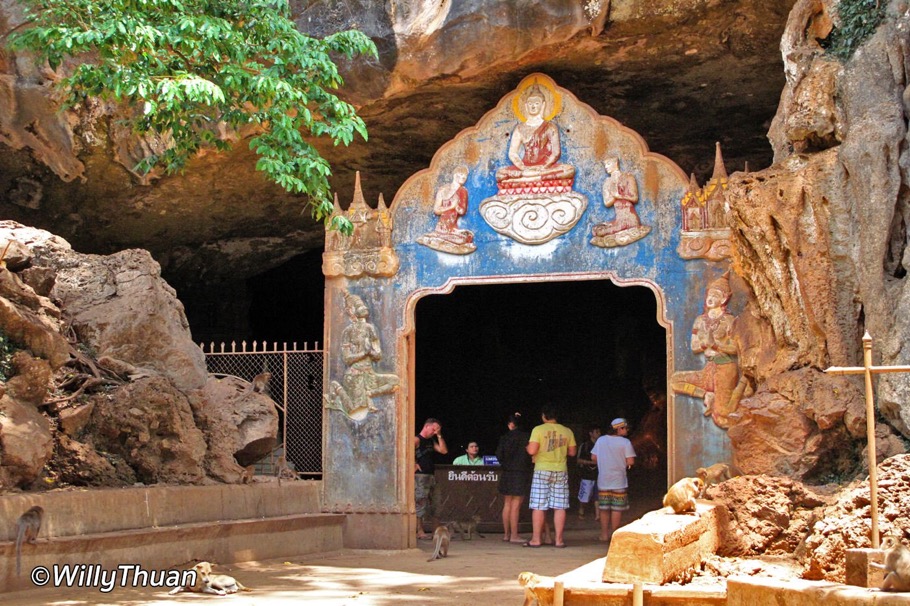
I'm not sure what constituted the temple, but everyone appeared to enter the cave with their shoes on, etc. We had kind of prepared by wearing longish shorts covering our knees, and t-shirts covering our shoulders. Inside you could see that those people who approached one or other Buddha to pray did remove their shoes. The cave is about 40 metres long and about 20 metres wide.
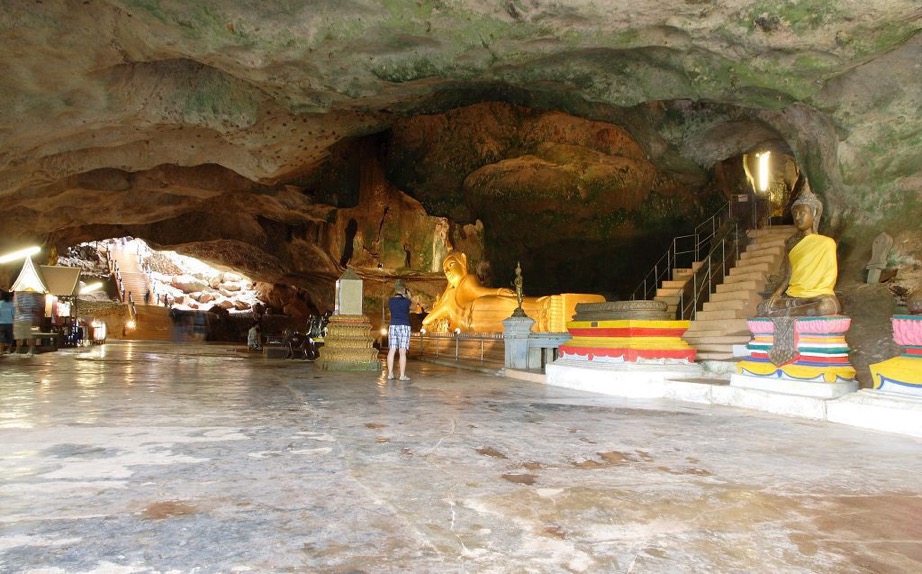
I found the above photograph on the Web and it captures the view you have when entering the cave. You can see that you can walk right through and there are stairs leading up to another cave, and eventually to the outside. However the main part of the temple (and visit) is in this single large cave.
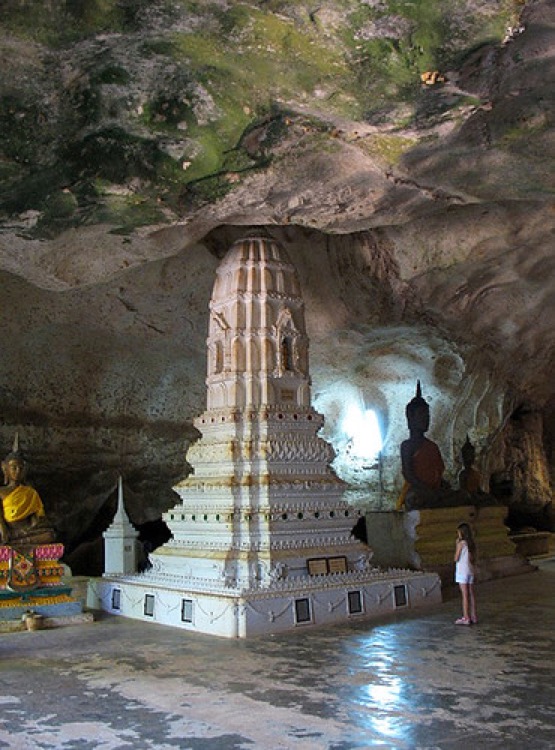
On the left there is the chedi or stupa housing the bones of the Na Takuathung family, who were local governors about 160 years ago, and who arranged for the building of the shrine. The chedi is just the Thai equivalent for the stupa, the usual conical or dome-shaped Buddhist monument used to house relics. In principle it is the most important and sacred structure in a temple.
Wikipedia has an article dedicated to Thai Temple Art and Architecture, and there is also a very interesting article "The Stupas of Myanmar, Thailand and Laos".
What we see above is one of the many types of Thai chedi, presented as a stylised, squarer version of the bell-shaped chedi, and in this particular case it also has corners with 12 indents. We can see that this chedi actually extends into the rock ceiling. Tradition has it that when a larger chedi was needed they were built encasing the old one, so in this case they might have felt obliged to cut a hole in the cave roof.
Although the Thai chedi can take on many forms, they nevertheless follow a certain number of basic principles. But first it's important to mention that a chedi can be quite small or it can be more than 45 metres high. So in northern Thailand the chedi takes the form of a solid looking cubic mass with a niche on each side for an image of Buddha in high-relief. There can be several storeys and it can be crowned by a domed or 'castle' stupa. In this type of design the relic chamber has this 'castle' form with niches containing Buddha statues. An extension of this design is a structure composed of several receding cubic masses, one on top of the other. The small family chedi in our cave temple Wat Suwan Kukha comes closest to this design. Below we have examples of the two basic designs, the 'castle' and the domed chedi.

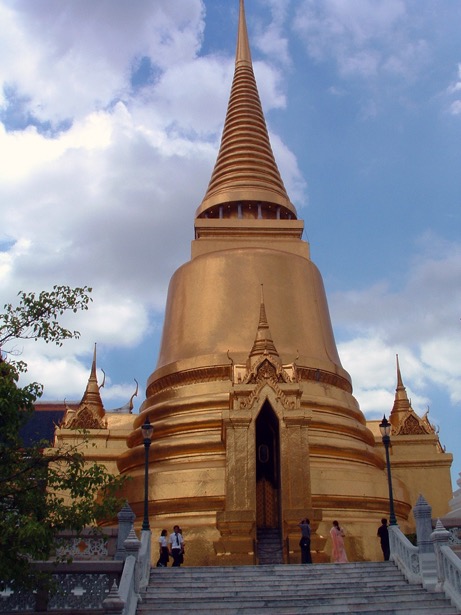
Then there is the round stupa, which is much closer to the Indian model introduced from Ceylon. Here the stupa has a high drum (or base) formed by concentric moulding of the same design each of decreasing diameter. The moulding can be circular or even four-, six- or eight-sided, but the basic design is in decreasing tiers. I'm not sure, but I've read that these tiers represent the Three Worlds (or Realms) in Buddhist cosmology, i.e. Sensual Desire, Material Factors and the World Without Material Factors.
On top of this base comes the bell-shaped dome, which is the relic chamber. This is usually round, but can follow the shape of the base. The dome can be quite small, or be the most substantial part of the chedi.
In one version, next comes a square throne symbolising the seat of Buddha. And finally on the top there is a low circular colonnade supporting a high and slender 'chatra' which is a kind umbrella, either open or closed. There is a version of this design that includes at the level of the dome four niches.
In another version the dome is toped by a small spire base. The spire itself is divided into a lower part representing the heavens, and an upper part in the form of a lotus bud representing Nirvana.
Right on top, the slender 'chatra' (that's the umbrella bit) is actually not considered part of the chedi, but tells us the importance of the relic.
Originally it is thought that a stupa or chedi were for keeping the Buddha's relics, however in around 1492 AD a stupa was built for the remains of a king and his son. Today only the square base remains of these early stupas. This may have been related to the idea of the divinity of kings and the idea that they would become Buddhas in the future. Stupas can be of many sizes and designs, and often they were called 'Lankan chedi' or 'Lotus shaped chedi', etc. Stupas in the North-East took the form of squares slopping upwards like an extended lotus stalk. Today stupas contain the remains of one's ancestors, and many families stupas imitate famous ones. There are even fakes or decorative props built in hotel compounds. The bell-shaped stupa started to appear in 14th C Chiang Mai, the capital of Lanna. One form had multiple spires, and the other a single spire on a bell-shaped stupa. In the 17th C a new type of stupa was created, the 'redentation' style of stupas, i.e. corners were cut into multiple corners in zigzag forms, and this style is still popular today. A decorative version of this type of stupa appeared in Bangkok in the early 19th C.

On the right as we enter the cave, we have the 15 metre long reclining golden Buddha. We can see that the two people have removed their shoes and are sitting so that their feet do not point towards the buddha.
There are a number of other statues of Buddha around the walls.

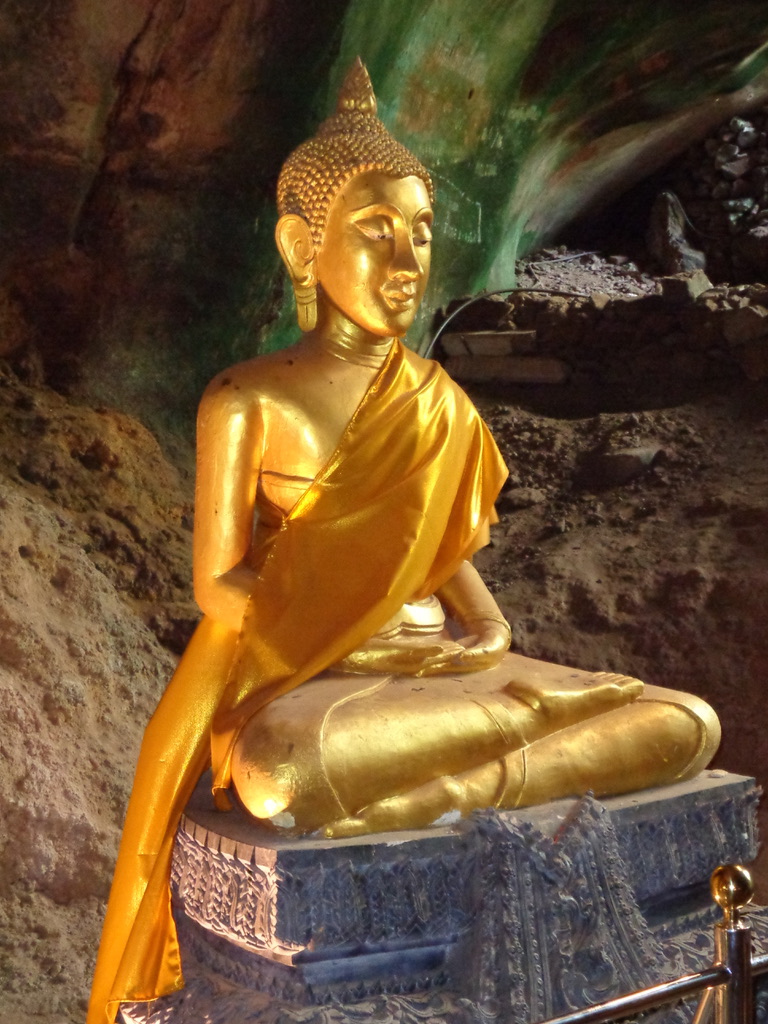
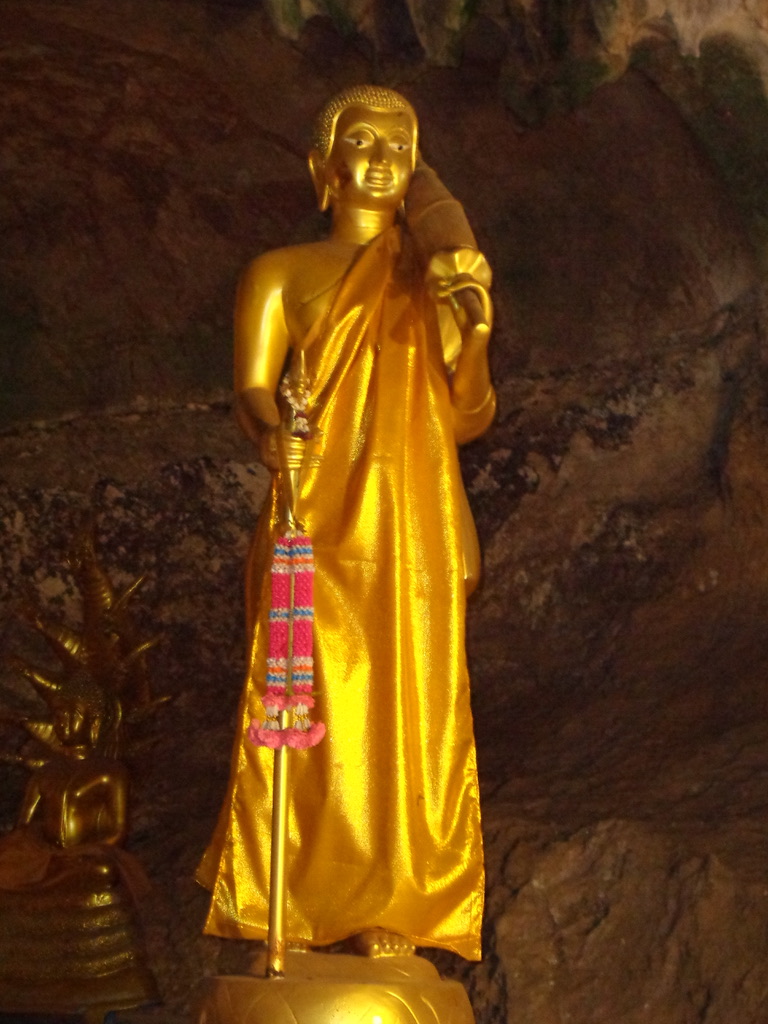


Further up the stairs there is a small statue dressed in a simple white sheet, which I presume is meant to be Buddha before his enlightenment.

This temple is also called the 'cave temple', or the 'sleeping buddha cave', or because of the monkeys that inhabit the cliff face, the 'monkey temple'.
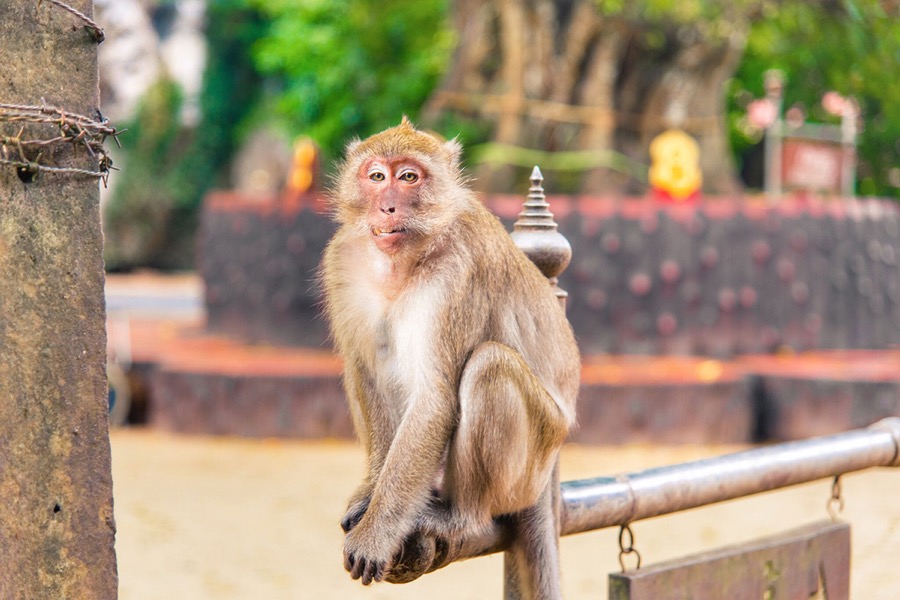
The first thing that intrigued me was the meaning and importance attributed to the statues of Buddha.
It was around 500 BC that Siddhartha Gautama set out to discover the meaning in the suffering he witnessed. When he could not find answers in traditional wisdom, he decided to meditate under a Bodhi tree. After 49 days he became Buddha, or the “Awakened One”. Once he found enlightenment, he began to spread his philosophy. Buddhism arrived in Thailand from Sri Lanka, and it became the dominant religion in both Thailand and Laos in the 12th C.
You do see some texts mention Buddha under a Banyan Tree. Strictly speaking they are two different varieties of fig. The Bodhi is Ficus religiosa and the Banyan is Ficus benghalensis.
As I understand it, Buddha statues are used to convey the religion's teachings. The statues were symbols used in a pre-literate, oral culture to pass on messages. The head of Buddha is usually depicted with short, curly hair. This means that he had cut off his topknot showing that he had renounced his privileged past. The fact that his hair is neither long nor very short, represents life between the extremes of indulgence and mortification. His eyes are half closed, showing a state of meditation in that he is able to look outwards and inwards. Elongated earlobes means he hears what is needed in the world. A dot on the forehead means wisdom and a third eye to see unity. A full mouth indicates eloquent speech. Long arms signify generosity. White, slender fingers symbolise mindfulness, precision and purity in every act. Round heels represent an even temperament, and the fine webs between toes and fingers signal interconnectedness.
Although there are thousands of statues of Buddhas, the general look and expression are similar, i.e. solemn, quiet, sublime and perfect. Differences between Buddhas are in the doctrine objects, sitting postures, clothes and the hand gestures (mudras) which have a range of different meanings.
We know that when Siddhartha Gautama renounced his privileges and his home and family, he also traded his fine clothes for those of a mendicant seeker. I think the small Buddha dressed in a simple white sheet in the upper cave of Wat Suwan Kukha may represent Siddhartha Gautama before his enlightenment. But I'm not sure because tradition has it that he wore scraps of cloth sewn together, and dyed a generic earthy tone. However the image looks to be of Buddha sitting with his questions and looking for the solution to the suffering of man.
Today what we usually see are idealised statues of Buddha after his enlightenment, and wearing a golden robe of classical simplicity. Naturally Buddhas robes are now cared for by attendants and replenished by donations.
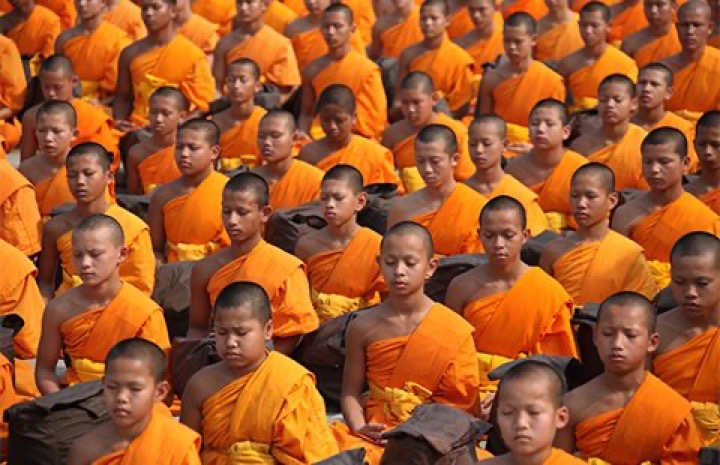
It is said that a king named Bimbasara, a friend and protector of the Buddha, wanted to pay homage to monks but could not find them easily in crowds. It was decided to make a layered robe that would depend upon the weather and activity of the monk. The most obvious one is the normal monks robe (kasaya) with a five-fold or five-column rice field pattern surrounded by a border. This robe is regarded as symbolic of a Buddhist's relationship with Buddha and his teachings. They also have a lower robe which wraps around the waist to the knee like a sarong. The third robe consists of two layers and is used to keep warm, and can be spread out as a seat or bedding. Because of the extreme cold in China, they later added layered Taoist-style jackets and wrapped leggings and split skirts (pants). Later still, ties and straps were added to help keep the robes in place. As Buddhism expanded across the world, so the robes changed and evolved, and today most use man-made fabrics, but what has remained constant is the textiles simplicity.
Originally the colour was probably a yellow/reddish brown depending upon the dyes used and washing. The washing would probably have been with saffron or turmeric. It is said that the idea of a yellow colour was that it would not show dust and soil when the wind was blowing.
Today Buddhists wear grey or black in Japan, grey, brown or blue in Korea, and brown or yellow in Vietnam. In Tibet the colours can range from yellow, orange through to purplish-red. The Theravada monk in Thailand wears orange.
If you look carefully at the different Buddhas you will see some sitting, some standing, one laying down, etc. We saw a series of eight small Buddhas in glass boxes with a donations cup in front of each. For each day of the week there is a different Buddha, and you pay respect to the Buddha that represents the day on which you were born. If you are careful you will in fact find far more than just seven or eight postures, and you will also find different explanations.
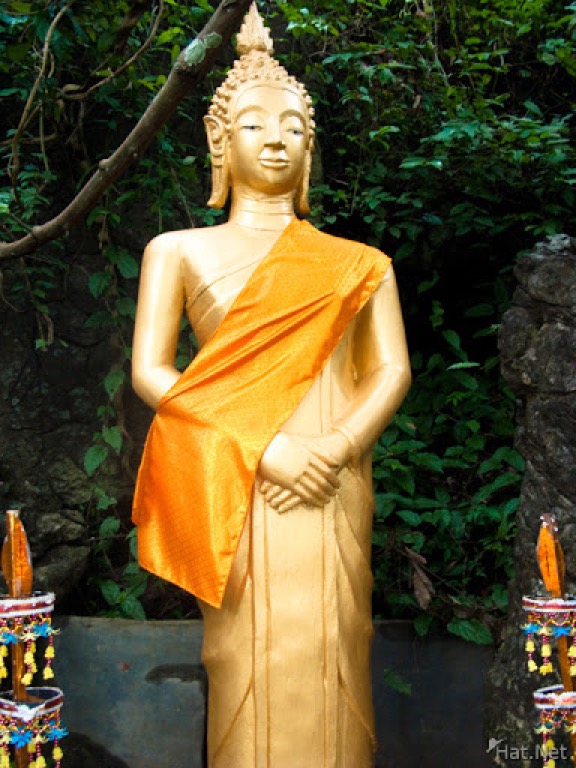
The Sunday Buddha is called Pang Thawai Net ('Seven Days Looking') and stands arms crossed in front of his waist, with the right hand covering the left hand. Buddha achieved enlightenment while sitting under a Bodhi tree. This image represents a time just after Buddha achieved enlightenment when, for gratitude, he stood and admired the tree for one week without blinking an eye.
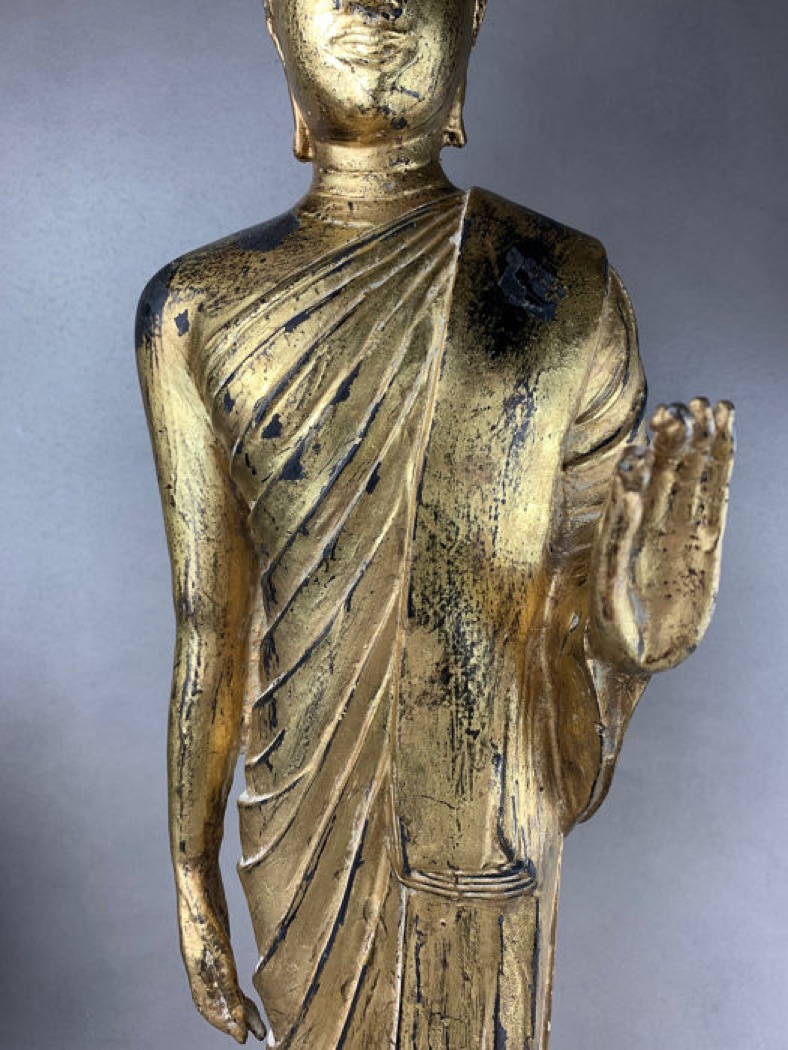
The Monday Buddha is called Pang Ham Yati ('Pacifying the Relatives') and stands with the right hand raised to shoulder height with the palm out, and the fingers extended (Abhaya Mudra or Abhayamudrā). When Buddha returned from heaven after three months, his relatives were arguing about the rights to water flowing through their land. Buddha pacified his relatives, and persuaded them to compromise.
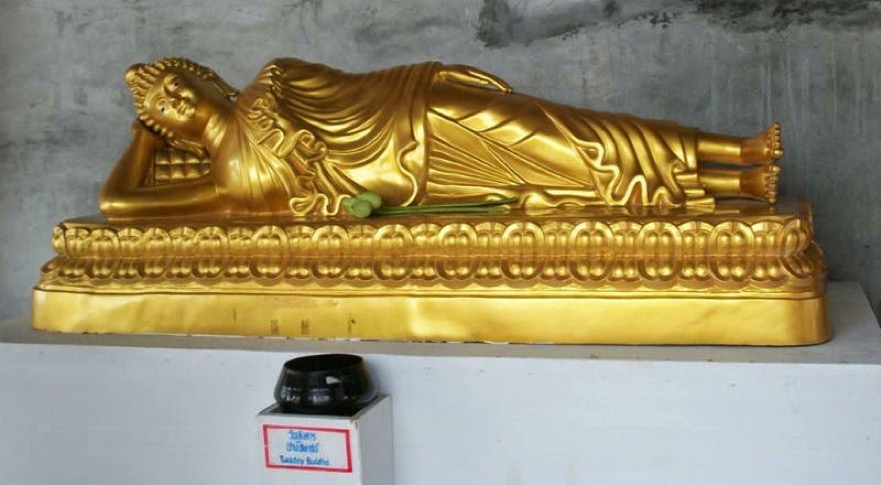
The Tuesday Buddha is called Pang Sai Yat ('Realising Nirvana') and lies on his right side, head resting on his arm, toes even. While the Lord Buddha was staying at Sāvatthī, there was an arrogant evil named Asura Rahu. He was so gigantic and didn’t pay respect to the Lord Buddha. So the Lord Buddha made himself bigger than the evil one even in a reclining position, thus lowering the pride of Asura Rahu. Seeing so, the evil one succumbed and agreed to accept the teaching of the Lord Buddha.
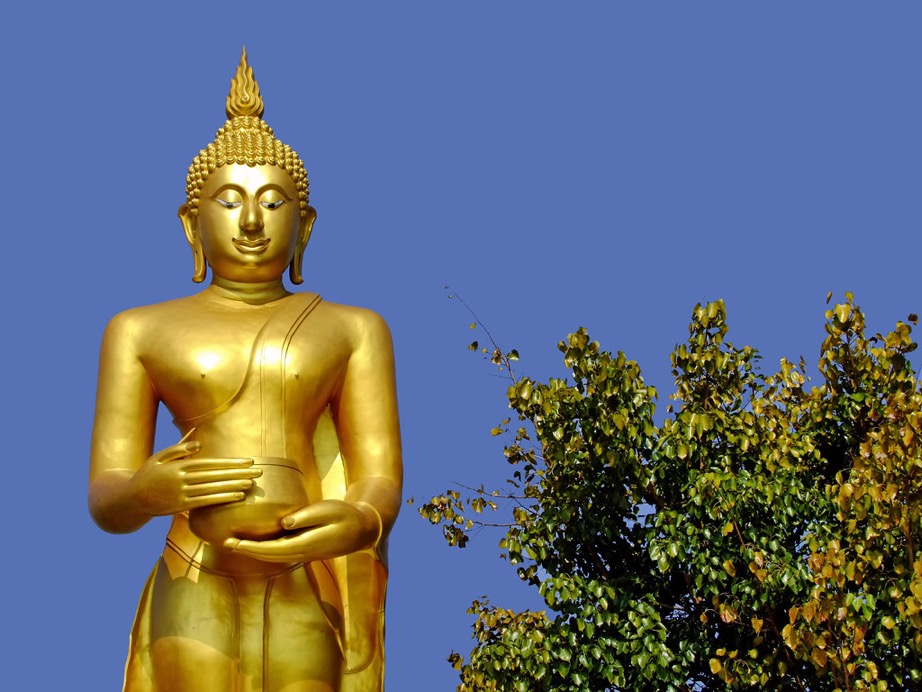
The Wednesday Buddha is called Pang Umbat ('Seven Days Looking') and is standing with heels pressed together and holding an alms bowl at waist level, with both hands. It indicates the time Buddha returned to see his father after four years in a monastery. In the early morning, monks make their alms rounds to collect food. Buddha did the same, and his father was appalled that Buddha was “begging” for food. Buddha calmed his father, informing him that it was important for Buddhas to perform ‘Pindabat’, i.e. to be available to followers who devotedly bring food.
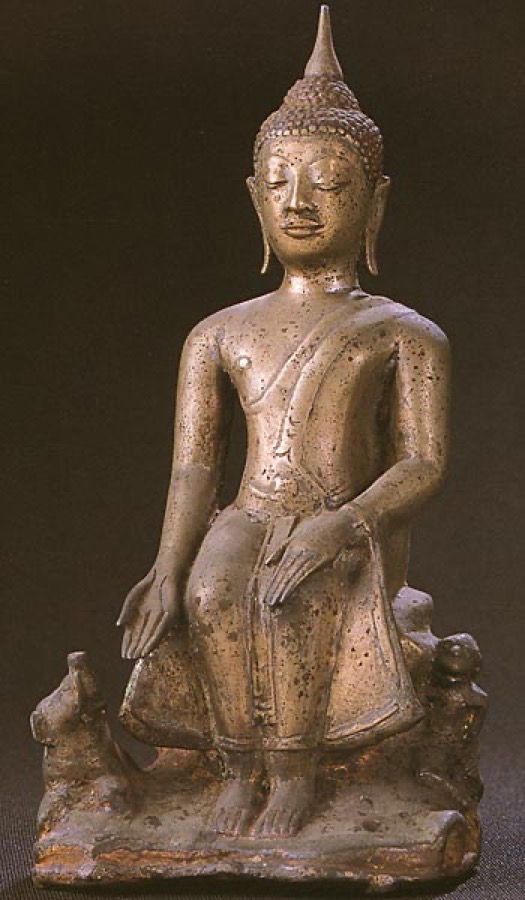
As mentioned, alms are collected in the morning (from 06:00 to 17:59), so there is also a Wednesday Evening Buddha called Phra Lae Lei ('The Blessed One'). Here the Buddha is seated receiving gifts from a monkey and an elephant. Buddha was tired of the monks of Kosambi being split into two groups and not being in harmony. He retired into the forest where an elephant Palilayaka attended him, and a monkey offered him a beehive. The festival Madhu Purnima celebrates this moment.

The Thursday Buddha is Pang Samti ('The Meditating Buddha') and is sitting in a full lotus position with soles upward and visible, the hands resting in the lap, right above left with all fingers extended, palms upward (Dhyani Mudra). After receiving bundles of grass from Sotthiya, he scattered it and made it into a seat under the Bodhi Tree. He made a vow “Skin, sinew and bone may dry up as they will, my flesh and blood may dry in my body, but without attaining completed enlightenment, I will not leave this seat”. With his strong determination, he achieved enlightenment. In this position of restful meditation it is believed that the body is receptive to power and energy through the top of the head and the open palms.
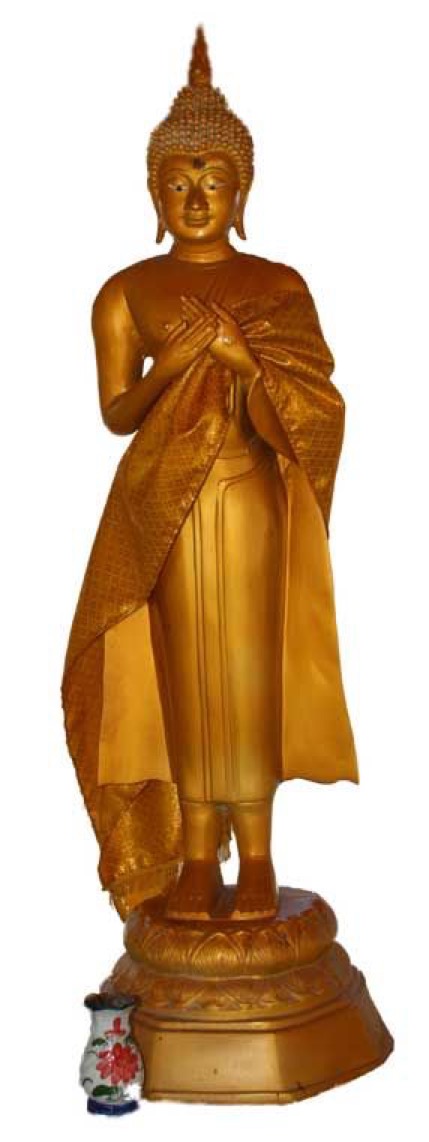
The Friday Buddha is Pang Ram Pueng ('Contemplating Buddha') stands with both arms crossed over his chest with the right hand covering the left. A short period after the enlightenment, while the Lord Buddha stayed under the Bodhi Tree, he stated that it was too difficult for ordinary people to understand Dharma and bring it into practices. He was discouraged from teaching the Dharma.
"This Dharma that I have found is profound, hard to see, hard to understand; it is peaceful, sublime, beyond the sphere of mere reasoning, subtle, to be experienced by the wise. But this generation takes delight in attachment, is delighted by attachment, rejoices in attachment, and as such, it is hard for them to see this truth, namely…Nirvana. However, with his great mercy and loving-kindness, he clearly understood that living creatures possessed different habits just like the nature of a lotus."

The Saturday Buddha is Pang Bak Prok ('Protected by the Nāga King') and sits in meditation, in a full lotus position on the coiled body of the nāga Mucalinda that uses its head as a cover against rain. This represents a time during the sixth week after Siddhartha’s Enlightenment when the Nāga King protected the meditating Buddha against heavy rainfall by making a shelter with his multi-headed hood and lifted him above the floodwaters by coiling its body under him.
The traditional Thai house (in Phuket)
Before looking in detail at some other Buddhist temples, let's have a look at the most historically important architectural development in Thailand, the traditional Thai house (see also Architecture of Thailand).
The basics of Thai traditional architecture is the same throughout the country, but each region (e.g. Phuket in southern Thailand) has some specific 'decorative' features.
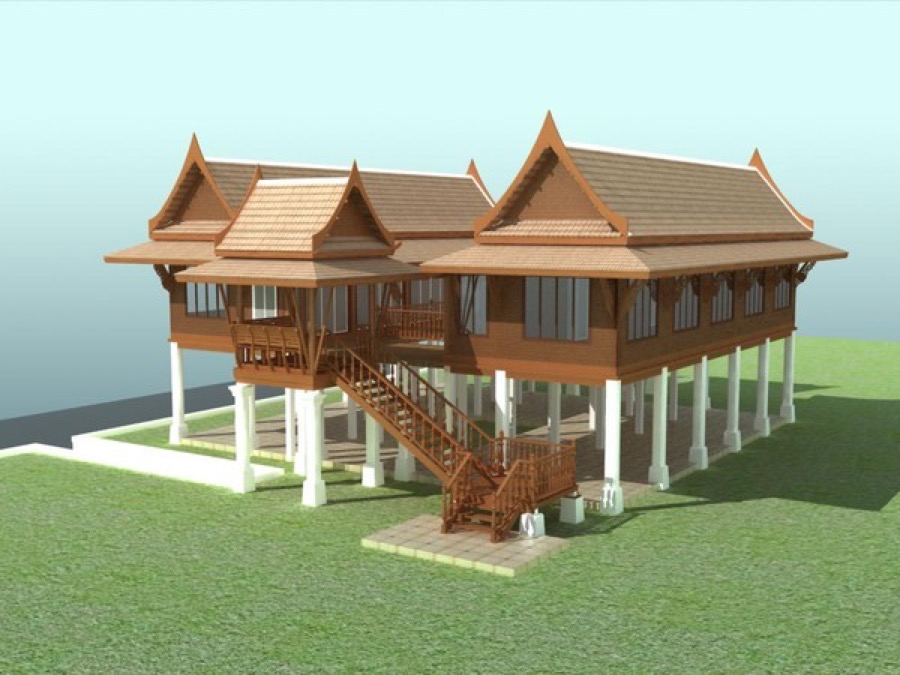
Traditional houses are elevated as a form of protection against flooding in the rainy season. Steep roofs mean that rain runs off quickly. Deep overhangs keep the rain out and provide shade. There is usually a fair amount of open space and much is done to allow good ventilation through the house. The construction technique is usually quite modular, meaning that Thai houses can be easily disassembled and rebuilt elsewhere. Everything was held together by wooden dowels and dovetailed planks, so a simple house could be taken apart in a day. In southern Thailand the terraces often have railings and elaborate stairs.
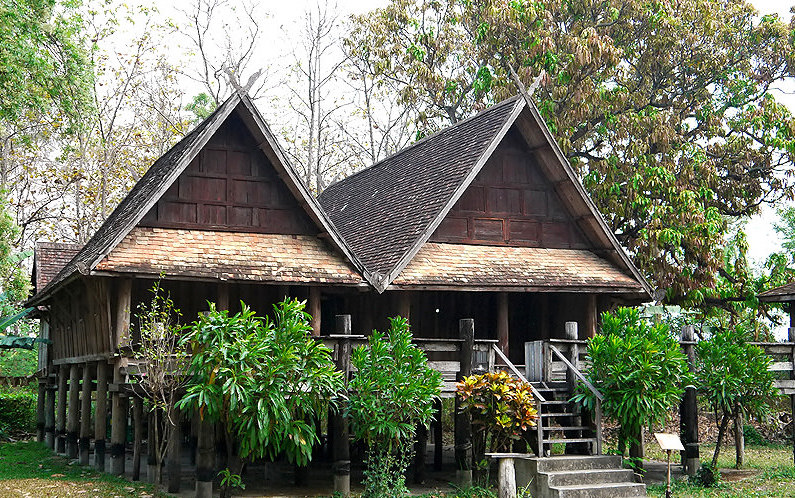
The Lanna Thai house is usually built from teak and is elevated. The space created under the house can be used in the dry season for weaving, etc. The house might consist of just two buildings each covering a single room, one a bedroom and the other a living/kitchen room. The roof would be steep sloped, tiled with double layers of small clay fired tiles. The tiles would have a small hooked end so that they could hang on small wooden lathes. The roofs of the two one-room buildings join together with a single large gutter that carries the rainwater away from the house. At the gable ends there would be a lower pitched roof, and the main roof would decrease in pitch to match the gable ends. The two buildings would be connected by a raised covered veranda used as an outdoor living area, complete with carved railings. Usually richer families would have richer decoration. The V-shaped extensions to the gable ends were a distinctive feature and could also be intricately carved. The ends of the gables are called bargeboards ('pan lom') and were originally put in place to prevent the tiles from falling off. The bargeboards in the North cross at the apex to form 'kahlae', a wing-like structure that wards off evil spirits. Other bargeboards have a decorative motif of a sloping body of the 'nāga' with the head rearing up at the lower end. Some of the bargeboards can be finished with little points all along the length of the boards, these represent the scales of the 'nāga'. The basic design of these houses was highly modular, and more units could be added, and connected by raised walkways. As family members married and left, grand parents would be able to move back to be close to their children.

Wat Suwan Khiri Khet (Karon Temple)
Karon Beach is a popular tourist destination, and is the second longest beach on Phuket (5 kilometres). You tend to only hear about the beach, but the town is well worth a visit (it is in fact a sub-region of Phuket Town). Reports vary from a tranquil family resort to a place with a raucous nightlife. So I guess much depends on how near you are to Patong Beach which is further North.

We visited a small Buddhist temple known as the Karon Temple. The temple is more famous for the Karon Temple Market which is held every Tuesday and Friday evening in the grounds of the temple (in the parking area in front of the temple). The usual stuff is on sale, but it's best known for the street food.
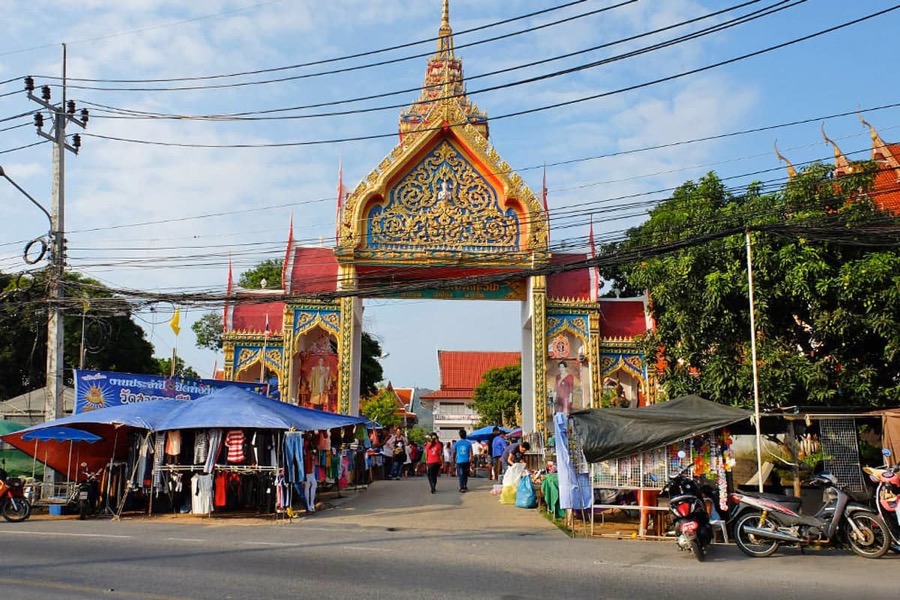
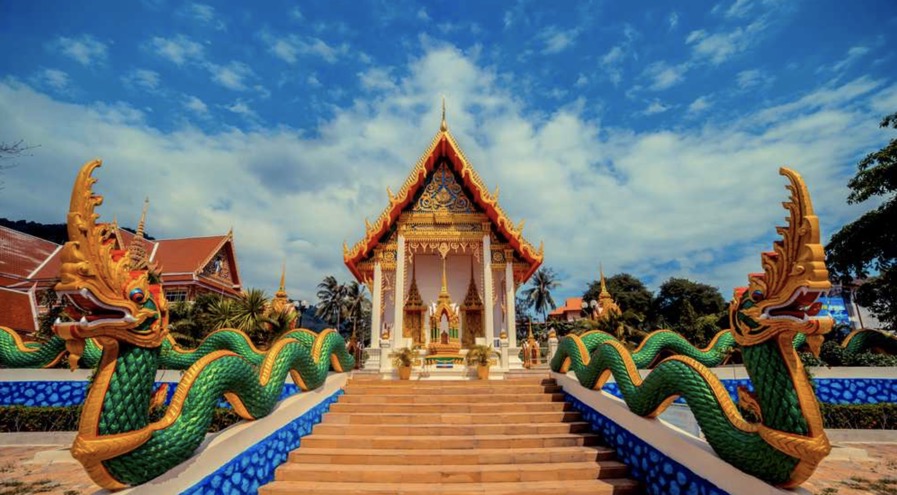
We visited the temple on one of its off days, so it was closed, and there were only a couple of visitors walking around. The main building is quite small and guarded by two large snakes (Nāgas) encircling the entire building. The above photograph is really impressive, and I should give a credit but I can't remember where I found it.
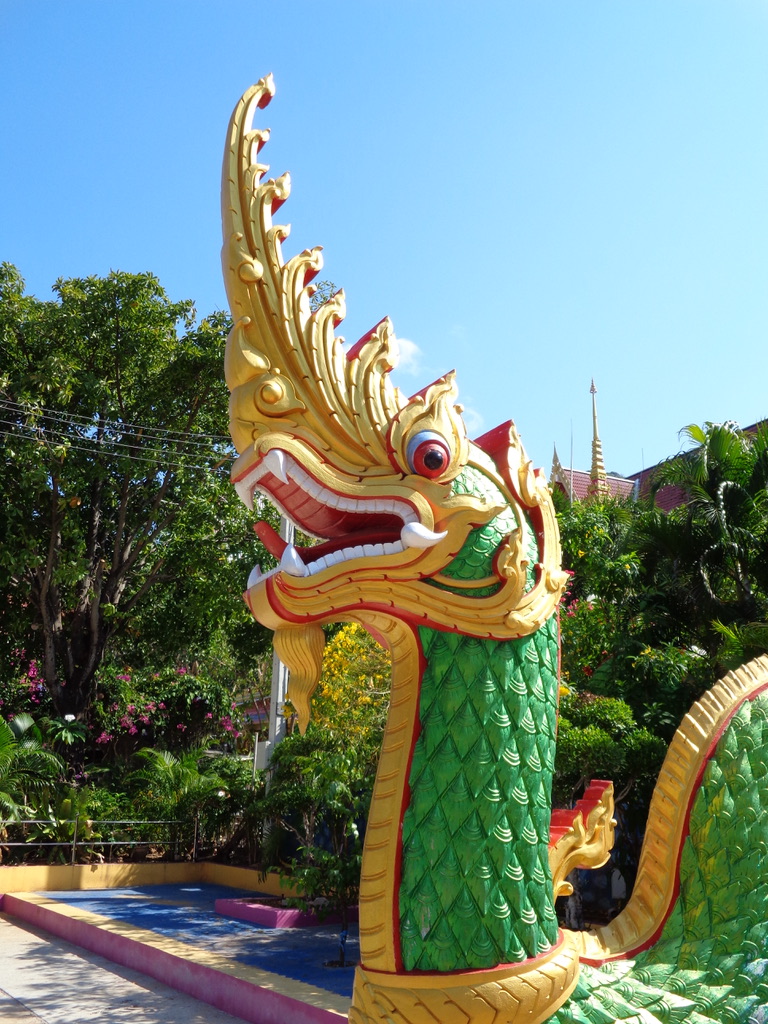
I've called the two monsters on the stairs dragons, but in fact they are called 'nāga'. And a 'nāga' is a semi-divine deity, half-human and half-serpent (originally an Indian cobra). They are a race that can appear as a human with snakes on their head and neck, or as a common snake, or half-human half-snake. According to Thai tradition the serpents we see on these stairs are Phaya Nāga, a serpent-like creature believed to live in the Mekong river. But in my mind they still look a bit like Vietnamese dragons. The Phaya Nāga is supposed to represent the boarder between the human world and the netherworld.
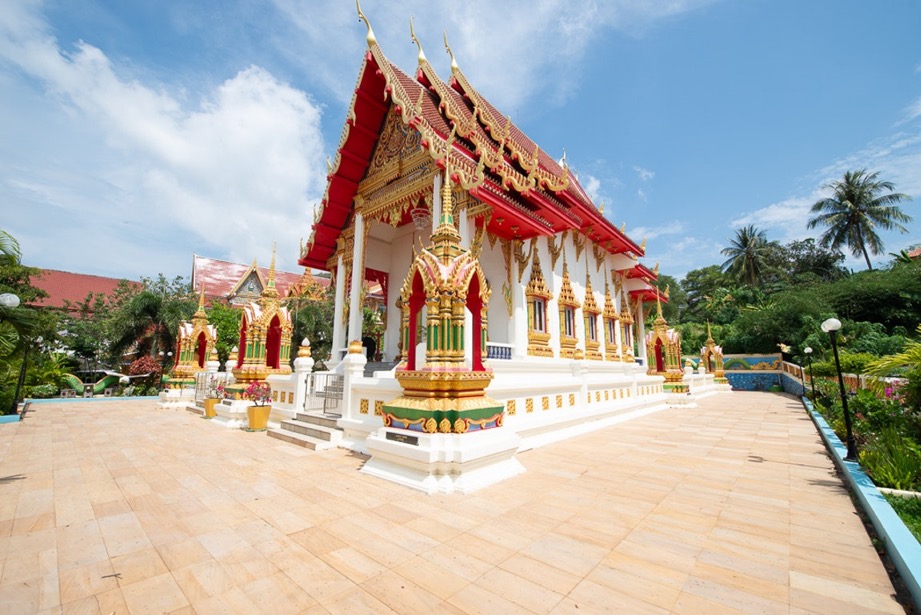
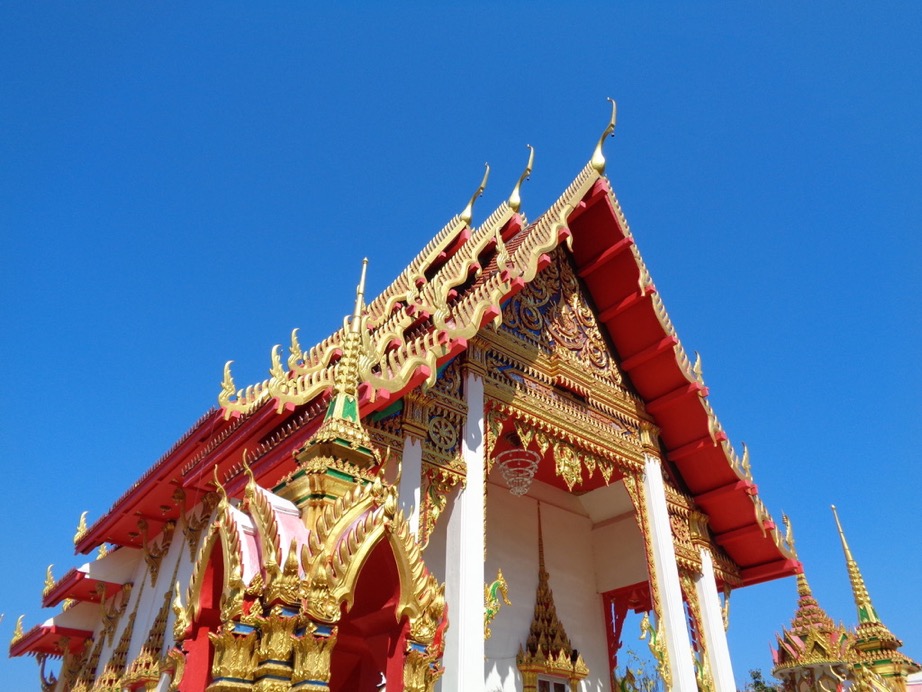
Above we have a fine example of a 'chofa', a decorative ornament that sits on the top of the end of the roof of a temple 'wat' and palace. It looks a bit like a bird, and is supposed to represent a mythical creature called a Garuda, half bird and half man.
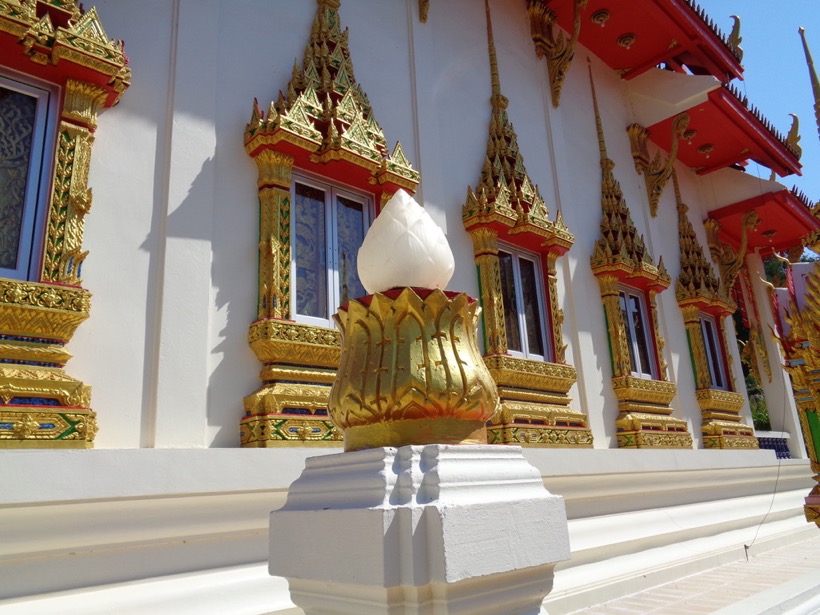
Another decorative element which is so abundant on Thai temples that it is often ignored, is the lotus blossom. I've picked it out in the above photograph. The Nelumbo nucifera originated in China, but its natural habitat ranges from India through to Japan, and even eastern Australia. It is the national flower of India and Vietnam. The lotus flower is often stylised as a lotus throne, or a pedestal for divine figures in Buddhist art and Hindu art. In Buddhism the lotus represents purity of the body, speech and mind (the Three Vajras). More generally the lotus is thought to represent a certain elegance and grace, and is often associated with the ideal feminine attributes. As a decorative items it fulfils a similar role to the palmette (e.g. in ancient Egypt), fleur-de-lis, water lily, pineapple, or tree of life.

In the grounds there was also a small temple for visitors to pray and make offerings, a large food hall, and another building that was protected by a supernatural being called a 'yaksha' or simply 'yak'. They are there to scare off spirits and protect the images of Buddha from harm.
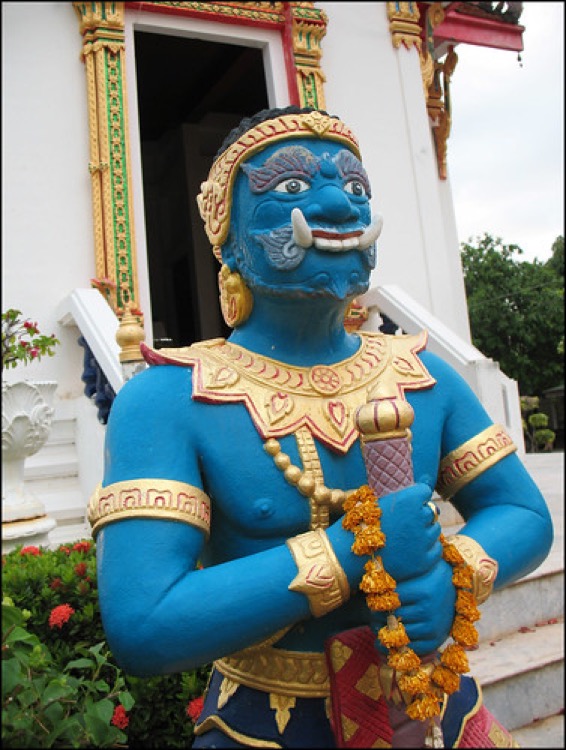
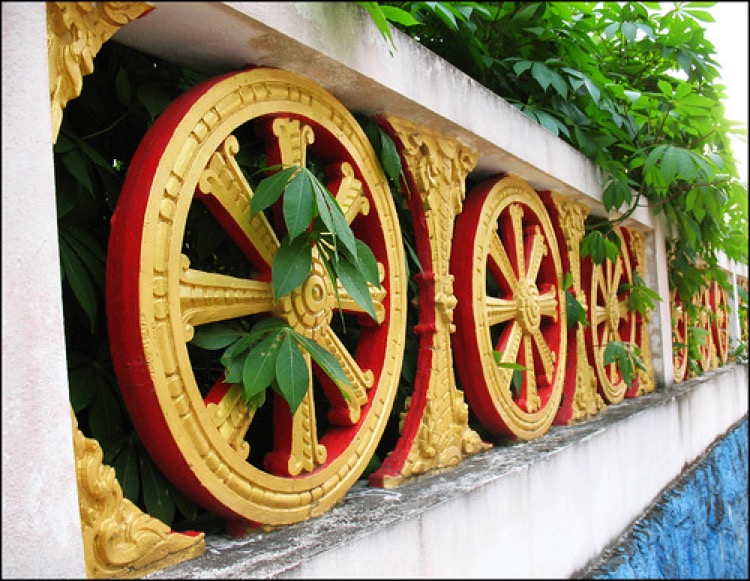
Around the exterior walls of the temple you can see multiple copies of the Dharma wheel. These wheels might appear to be stuck on an outside wall as decoration, but the Dharma wheel has a deep significance. According to Wikipedia the Dharma in Hinduism represents the order that makes life and universe possible, and includes duties, rights, laws, conduct, virtues and what they call the 'right way of living'. In Buddhism it's a bit easier, since it just represents 'cosmic law and order'. They call it the 'wheel of law', and it was set in motion when the Buddha held his first sermon. So, it's not a trivial decoration after all.
The eight-spoked wheel is also a symbol for the Noble Eightfold Path. It consists of right view, right intention, right speech, right conduct, right livelihood, right effort, right mindfulness and right concentration.
Phra Phutta Ming Mongkol Akenakiri or the Ming Mongkol Buddha (Big Buddha)
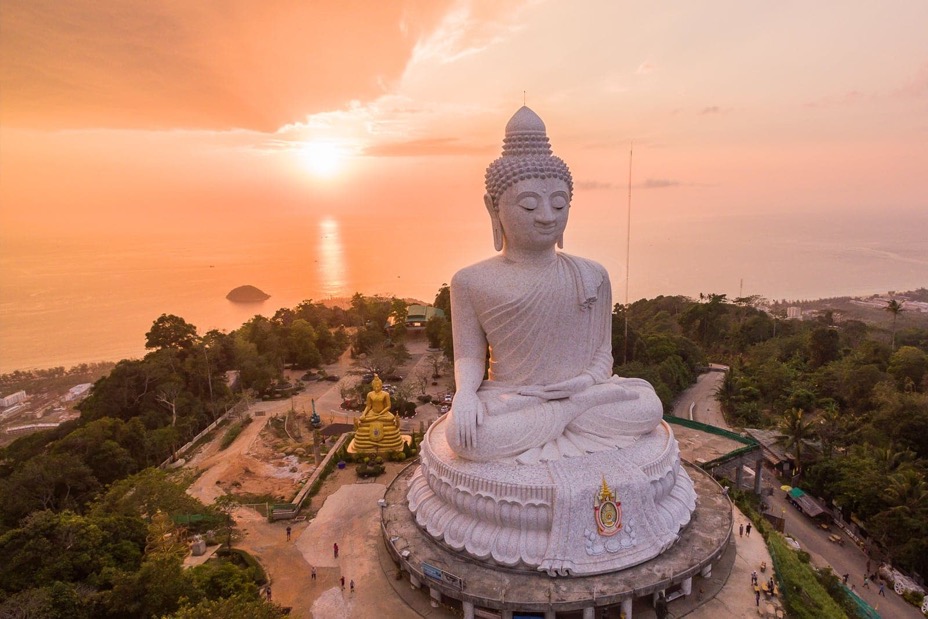
The 'Phuket Big Buddha' is a popular tourist attraction in itself, and you have in addition a great panoramic view over the island. The 45 metres tall Big Buddha sits on a 7.8 hectare plot on top of the Nakkerd Hill.
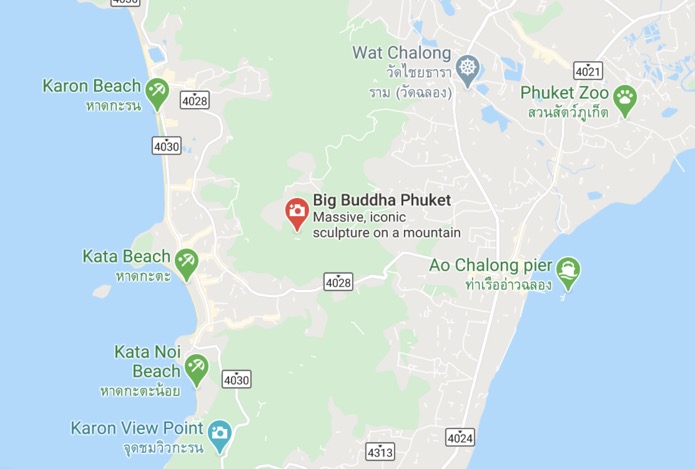
The name Phra Phutta Ming Mongkol Akenakiri means 'Happiness on top of Nakkerd Mountain'. It's presently being constructed, and is funded entirely by donations. The foundations were started when General Phijit Kulawanich laid the first stone 2002, and I've read that it will cost around 30 million Baht (nearly €900,000). People said that it will be finished in 10 years, but I have my doubts. The name was given to the statue in 2008 by Somdet Phra Sangharaja Chao Krommaluang Vajirañāṇasaṃvara, The Supreme Patriarch of Thailand. There is a very informative website with the catchy title of Phraphutthamingmongkhol-akenagakhiri (but part of the image collection was not working properly when I last visited it).
The whole Big Buddha structure is built with reinforced concrete and sits on 50 ferro-concrete piers 12 metres deep. It's covered in small pieces of white 'jade' marble 'Suryakanta' from Myanmar (Burma). The total surface area is said to be about 2,500 sq m, and the total weight of the marble used was 135 tons.
Just as a little additional precision, white jade marble usually comes from China, and it's cloudy white jade marble that comes from Myanmar.
It may not look it from the aerial view shown above, but this Buddha is only half finished, or even less than half.
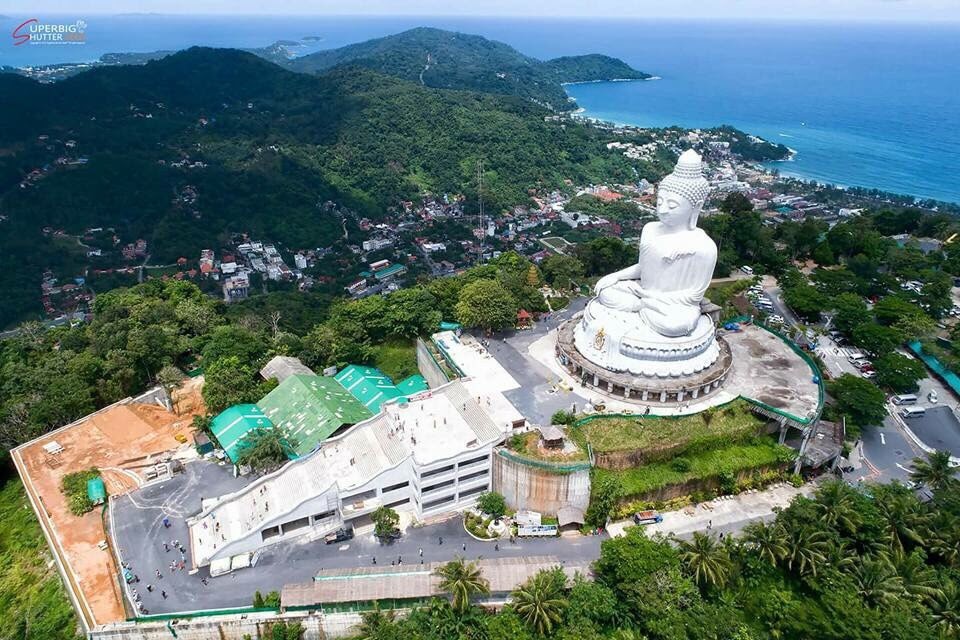
The first thing to do is walk around to the front. Above you can just about see on the far right of the photograph the free parking area behind the Big Buddha. You then have to walk around the bottom edge to get to the observation terrace in front of the stairs.
Even if it is not finished, the Big Buddha is an active temple and it demands a certain respect. Visitors have to dress properly and not speak too loudly or play around.
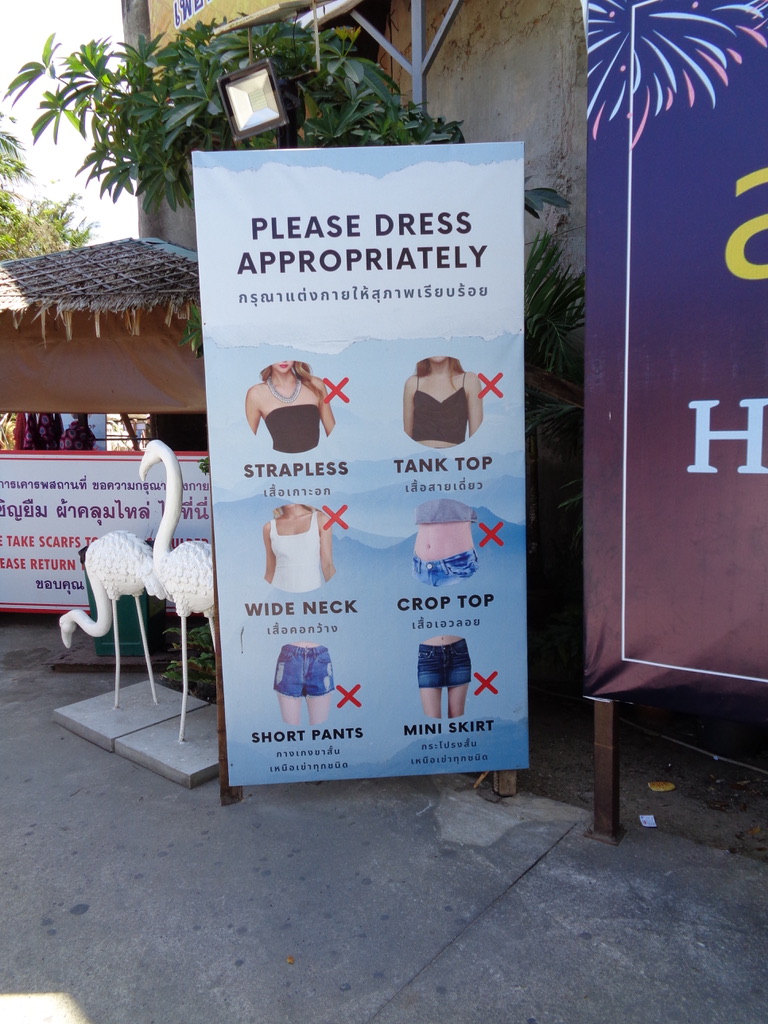
At the entrance they check your attire. No sleeveless t-shirts, no shorts or skirts above the knee, and they will give you a free sarong to cover your shoulders and legs.
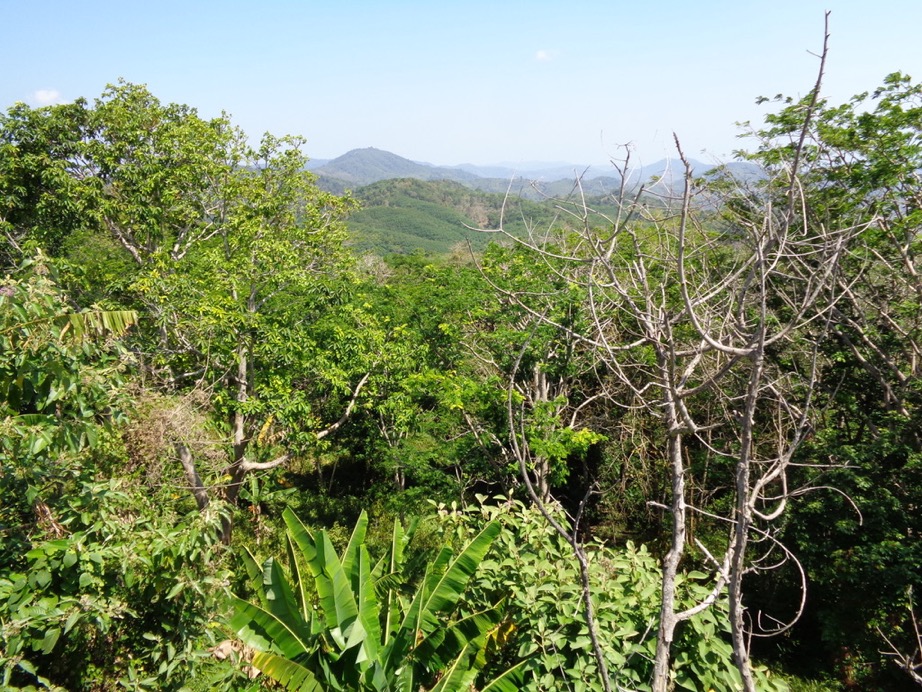
At the base of the Big Buddha there is an observation platform or terrace. As you walk to the terrace you can see that the Big Buddha is sitting on a hill, called the 'Nakkerd Mountain' in the large Nakkerd Forest Preserve in the Karon/Chalong area. There is an on-going struggle between the government and local people who claim ownership rights because they were already living in the forest before it was declared a forest preserve in 1973. And in addition there are warning signs to not feed the monkeys because they can be aggressive and bite (we did not see any).
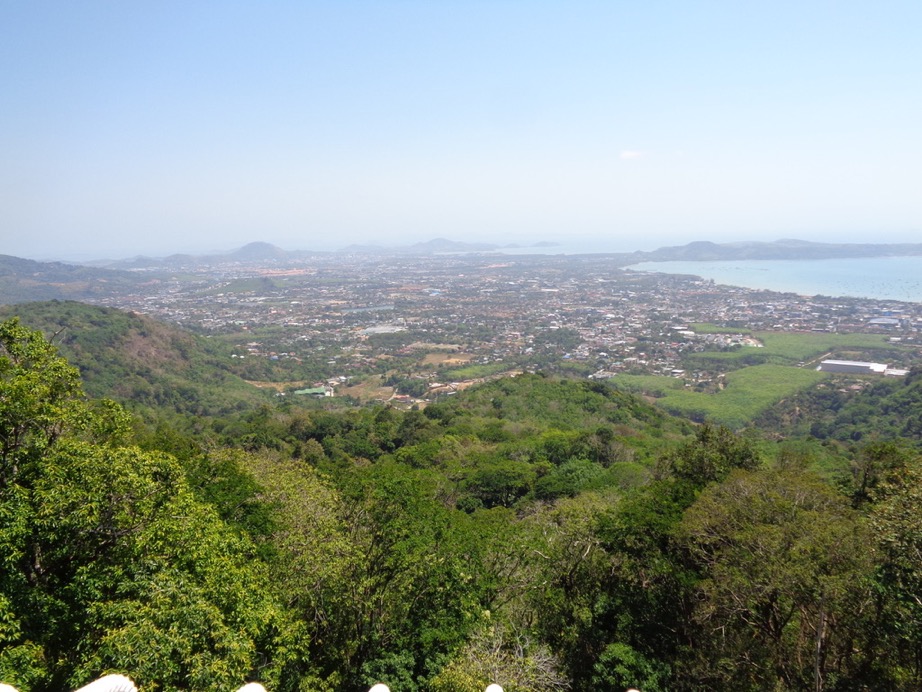
From the observation terrace we could see Phuket Town in the distance, and directly in front we have Chalong Bay on the East coast with the Chalong pier (see below). You just see Cape Panwa where they have the Phuket Aquarium. This is a less well known part of the island, and they say that Chalong Bay has a nice mix with the port, residential areas and a shopping hub. And Cape Panwa has some stunning yet little-known beaches.
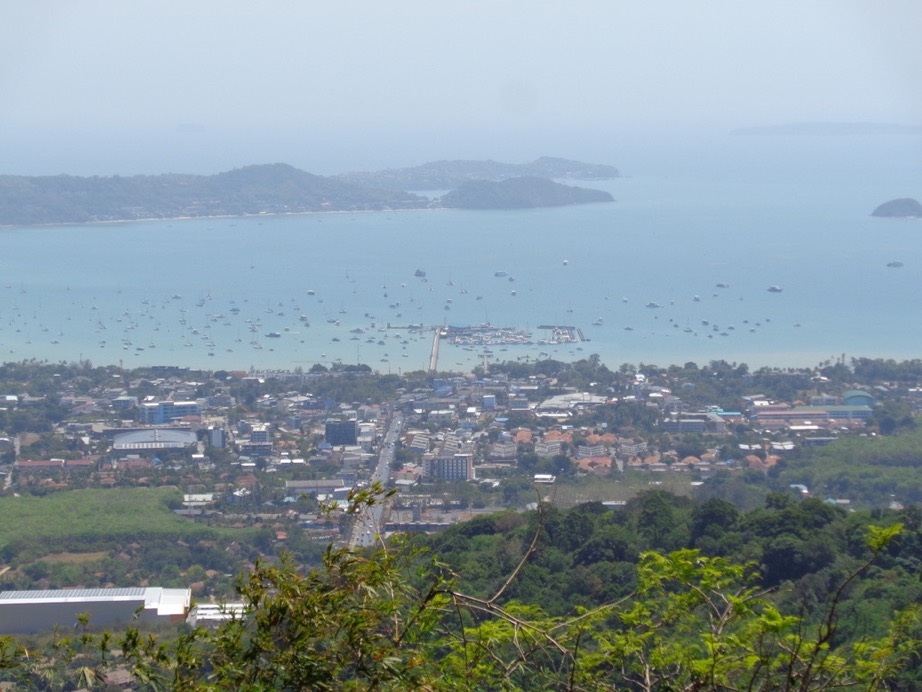

We turn our back on the view and look towards the wide 'crystal stairs'. Above we can see them being built, and below we can see them in February 2020.
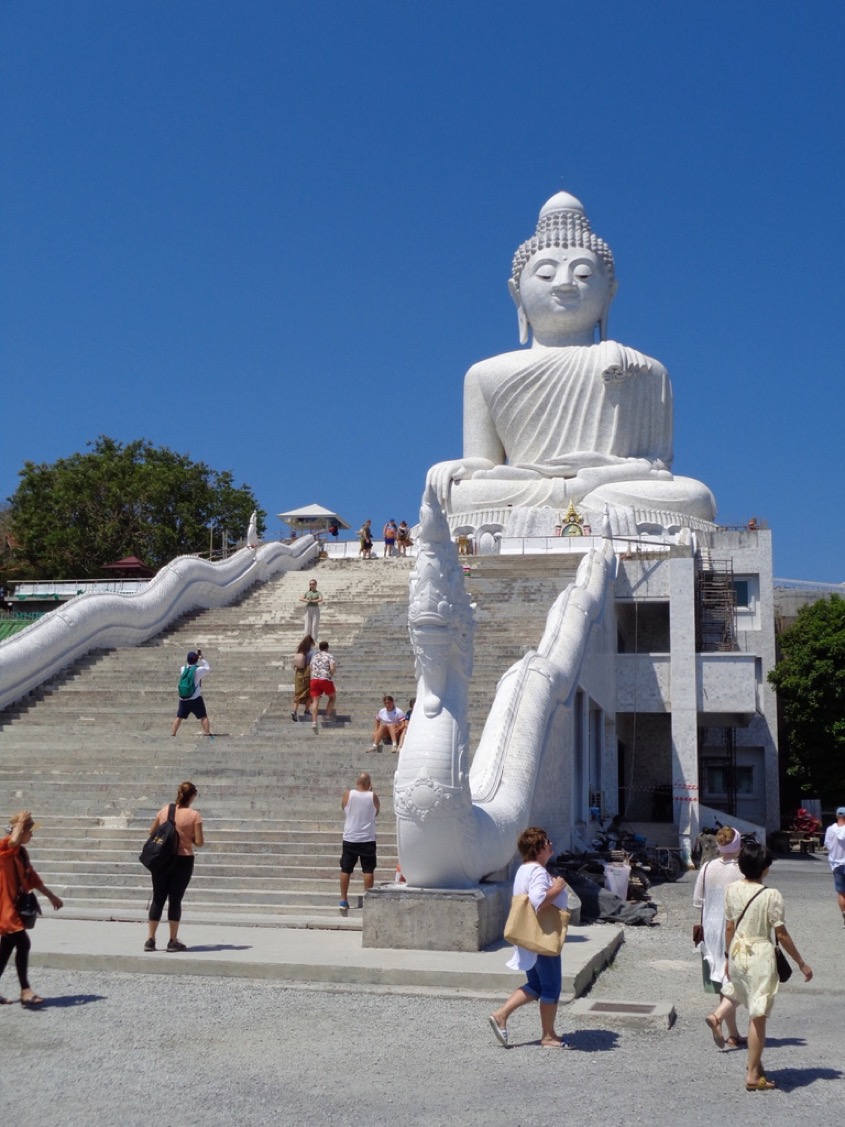
To reach to the Big Buddha on the top you have to climb 94 steps, and the exit route is by a side path that brings you down to the terrace area.

On each side of the wide stairs there is a massive nāga made from chuck's of that Burmese cloudy white jade marble.
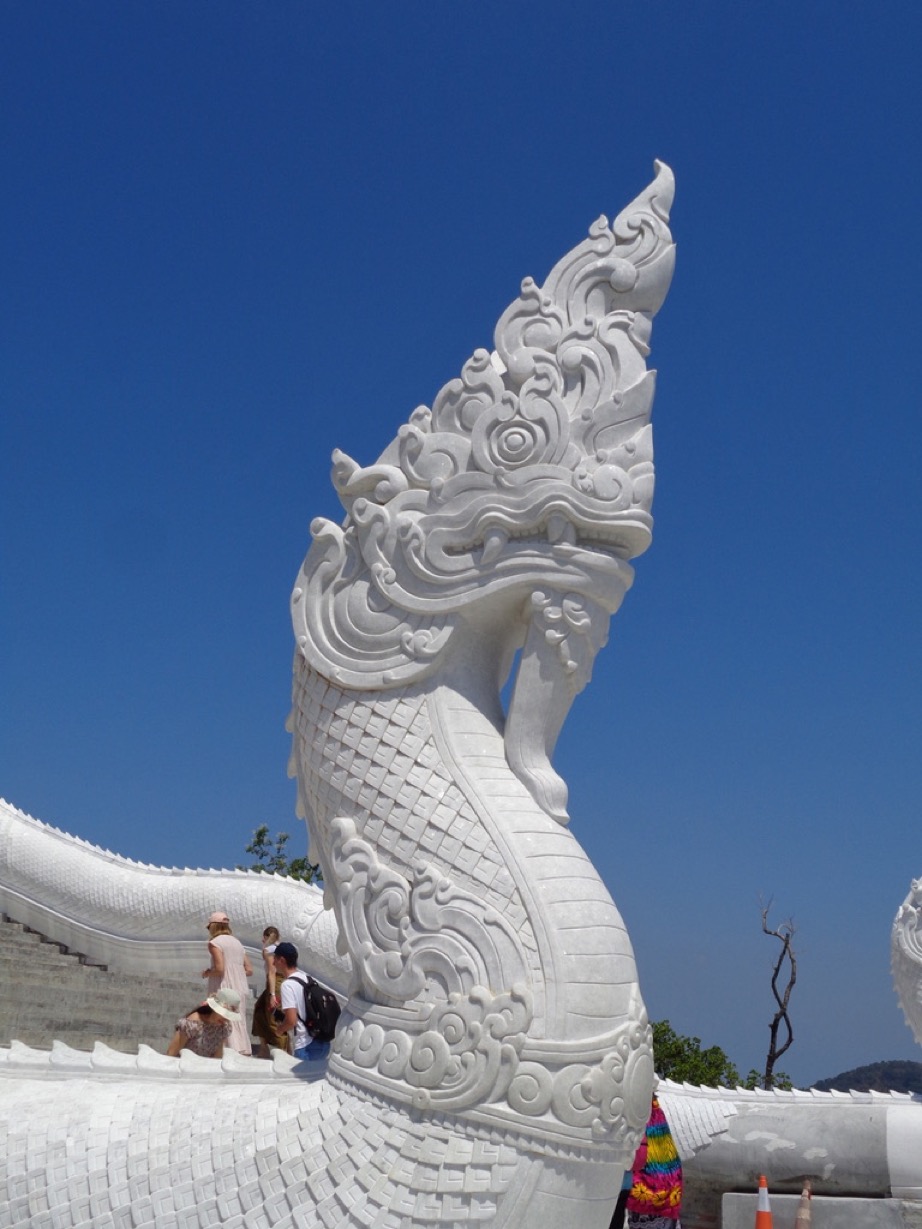
As you reach the top of the stairs you can see how the builders are progressing, with each small marble 'scale' of the snake hand worked and individually cemented into place.
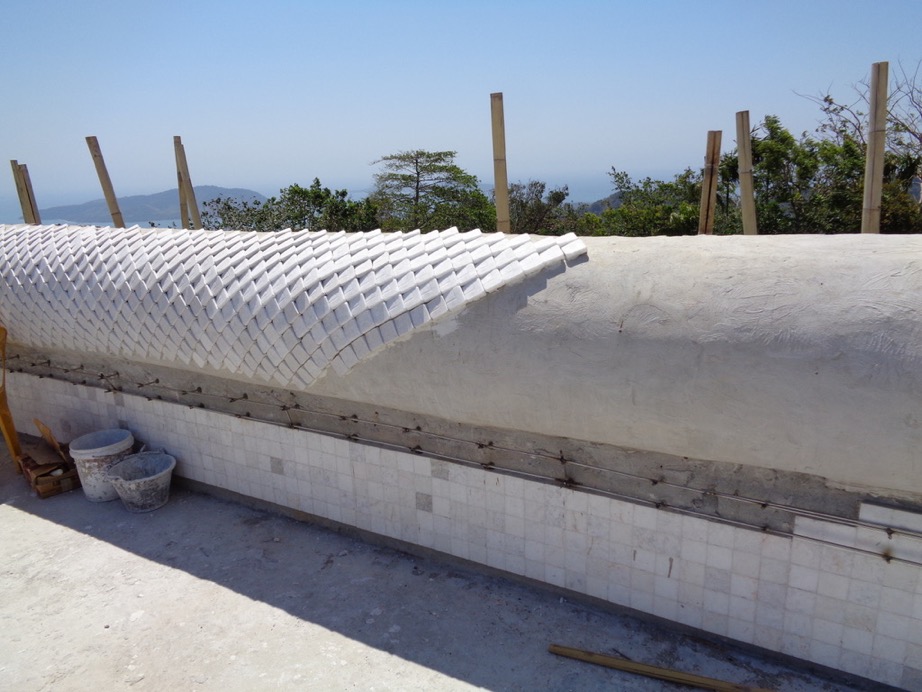
Finally we can now see the Big Buddha in all its splendour. But lets look at it's construction step-by-step. Below we can see a little of the lotus leaves around the base and the central support column for the head.
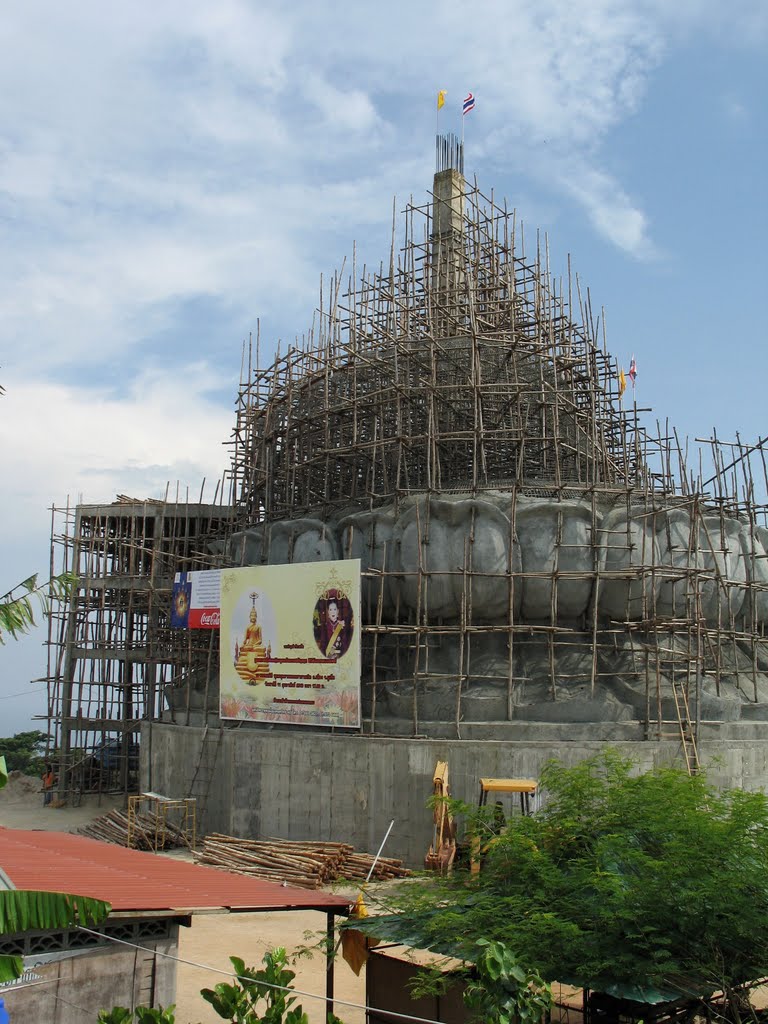
Below we have the full statue with all the scaffolding, and below that we can see the head during construction.

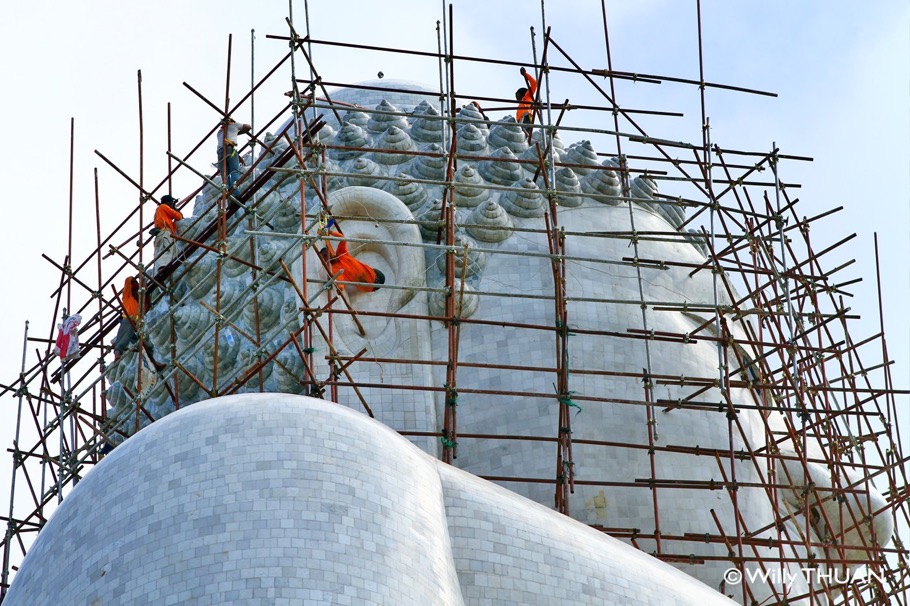
We can see how the Big Buddha is composed of thousands of small plates of marble. And how the ears were built up and then finally lifted into place. Each of the curls on the head of Buddha were built individually and then lifted into place. And the final result is …
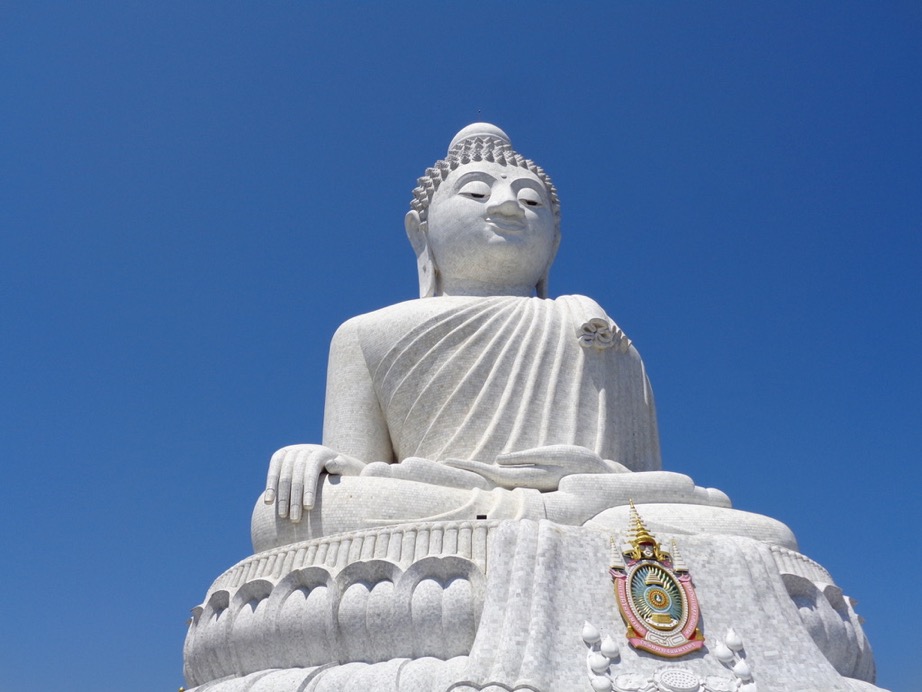
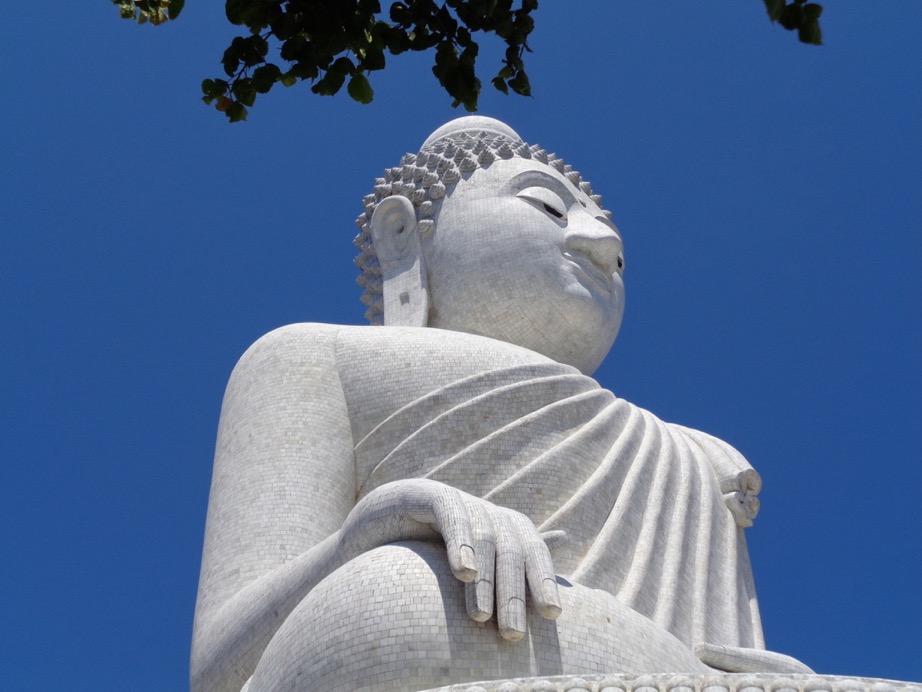
There is still a massive amount to work to finish the outside and do the inside of the statue, and they have estimated that it will take another 10 years.

On the same site there is a second gold-coloured Buddha, but it's 'only' 12 metres high. It's actually made of 20 tonnes of brass.
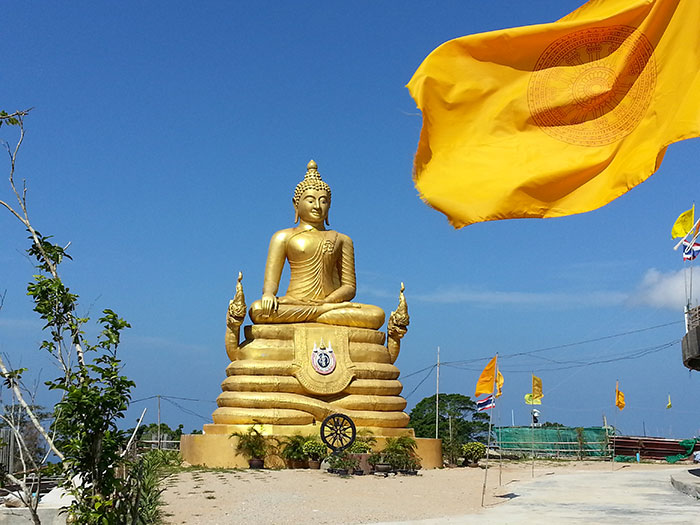
As a last thought I leave you with the stated objectives in building the Big Buddha.

The road to the Big Buddha is fine, but some parts are quite worn and damaged, and there are many curves and steep climbs. We stopped on our way down and had an excellent meal. The restaurant had both an open and covered terrance and a view to Chalong Bay.
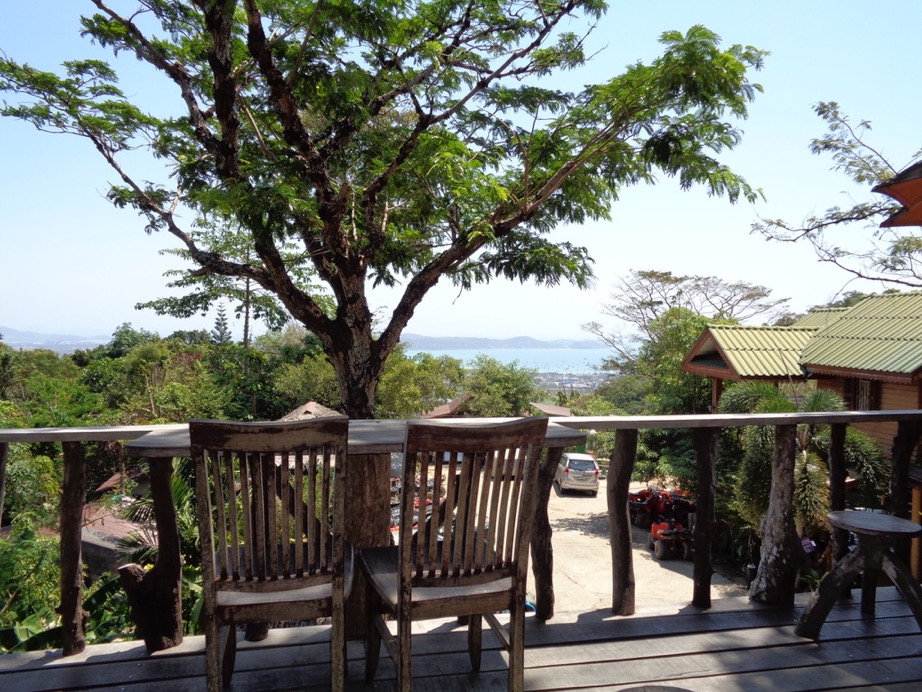
Wat Chalong
Wat Chalong is said to be the most important of the 29 Buddhist temples on Phuket Island. As you might have guessed it is located in the Chalong sub-district of Phuket Town. The temple was once called Wat Chaithararam, but everyone now calls it Wat Chalong.
The temple has quite a history, and I've copied a lot of information directly from 'Decoding Phuket's Wat Chalong'.
It is not known when Wat Chalong was first built, but records show it was relocated and rebuilt in 1837. There is evidence of an earlier temple on the same site (i.e. the remains of a wall). In 1876 Chalong was home to a rebellion, during which migrant Chinese tin mine workers (i.e. coolies) rioted across Phuket to protest about working conditions. Luang Por Chaem was abbot at Wat Chalong from 1827 to 1908.
Luang Por means 'venerable father' and it would be used as a title in front of names of senior male monks. Luang Por is the more official spelling, but Luang Phor was also used, and other translations suggest that it also meant something like 'reverend father'.
Not strictly related to our visit, but as useful background on the evolution of Buddhism in Thailand have a look at the 'History of the Thai Forest Tradition' and Dhammayuttika Nikaya, which were part of a reform movement founded in the 1820's by King Mongkut of Siam (1804-1868), who was also known as King Rama IV. It was Rama V of Siam who emphasised the role of the Thai clergy as educators, and Dhammayut monks were drafted to teach a new monastic curriculum designed to prevent the encroachment of Christian missionaries.
It would appear that the abbot became a key figure in the history of the rebellion because he was a mediator between the rivals, and at the same time he offered the temple as a sanctuary for the local population that felt threatened. In any case his actions gained enough time for the king to send an army to relieve Phuket. It is said that his funeral was the biggest ever held in southern Thailand.
One text mentioned that Luang Pho Chaem and another monk Luang Pho Chuang fought against the Chinese and with their knowledge of herbal medicine they were able to help the injured.
We are going to take a little optional deviation. You can of course just jump over this section and go directly to the description of the temple buildings.
Before we look at the temple grounds as they are today, it's perhaps interesting to examine this passing reference to a rebellion since the story of Wat Chalong is intimately linked with Phuket's history. It has to do with the 'ang-yi' which are often called a 'Chinese secret society', or even more diplomatically 'an unlawful organisation'. Through to the 1840's Chinese secret societies were known as 'tua-hia', and 'ang-yi' was probably just one of those societies. It would appear that 'ang-yi' was created sometime between 1809-1824. Chinese secret societies had already been involved in a revolt in 1735 against King Borommakot (1680-1738). Also in 1824 fighting broke our between opposing Chinese groups and the provincial governor had to intervene. It was in 1842 that three different 'ang-yi', each about 1,000 strong, again caused problems in the provinces. They were subdued and the leaders caught. But in 1845 we see the 'ang-yi' indulging in piracy, and in 1847 there was fighting between 'ang-yi' and Siamese troops concerning the traffic of illegal opium. In 1848 things escalated when the 'ang-yi' robbed a sugar factor, killed the Chinese owner, killed the local governor and took over the inner city of Bangkok. It took 10 days to subdue the revolt, and 1,000's of Chinese were killed by Thai and Lao troops.
In 1867 we hear of a major 'ang-yi' riot in Phuket. Two different 'ang-yi', the Ngi-hin and the Pun Thao Kong, fought each other over a problem of water used to wash tin ore in the mines. Nine leaders were caught and sent to Bangkok. There they had to declare on oath while drinking holy water that they would not cause further problems for the kingdom. In 1876 there was again fighting in Ranong, Bangkok and Phuket.
Many of the conflicts were between rival 'ang-yi' groups, with the Thai army stepping-in to restore law and order. Now Chinese immigrants in Thailand brought with them both guilds and secret societies. To find a job you had to belong to one of the guilds, and there were constant conflicts between different guilds to gain influence. 'Ang-yi' controlled manpower in the rice mills, saw mills, and railroad works and they provided support when the guilds fought (seen to an outsider as a kind of 'strike'). It was the 'ang-yi' that taught the guilds that the 'strike' was a very powerful weapon. The 1876 revolt was by Chinese mining coolies under 'ang-yi' leadership and started in Ranong. The tin miners revolted against the Chinese owners, who were supported by the local governor. The miners entered Ranong and killed many local people and government officials. Workers in Phuket also did the same in solidarity with those in Ranong. At one point 2,000 Chinese burnt and looted the city of Phuket, and it was only the arrival of regional troops that stopped the riots.
It would appear that taxes on tin mines (for example in Phuket) were increased in the early 1870's, and this coincided with a fall in tin prices in the mid-1870's. Mines became unprofitable, and mine workers were laid off. It is said that the mine owners were part of the local 'ang-yi' and they started to become increasingly aggressive in demanding a tax reduction. The Phuket authorities had lost the respect of the Chinese, and reports suggested that soon more troops would be needed. Some reports continue to use the term 'ang-yi', but others use the simpler term 'triad'. I prefer to keep with 'ang-yi' and use 'triad' for the emergence of organised crime post WW-II. Once the riots in Ranong were suppressed, some rioters fled to Phuket. The military commissioner in Phuket ordered a second Siamese gunboat to Phuket. When they docked some drunk Siamese sailors got into a fight with some Chinese miners. Two of the Chinese were arrested, and this sparked the anger of 300 coolies. The two were released but it was too late. Some 2,000 Chinese coolies started to attack government offices and loot the town. Some reports say more than 100 people were killed, and the local population fled, many to Wat Chalong.
Chum Bunnag, the military commissioner, met with Chinese clan leaders, and listened to their three demands. Firstly, suspend the heavy taxation. Second, they must be allowed to grow and export marijuana. Thirdly, there must be an amnesty for rioters. The commissioner accepted, but the riots continued for several weeks. The Thai leadership thought that this loss of the rule of law in Phuket might be used as an ideal excuse for the British to intervene. They had just used the mining wars in Pahang (Larut Wars) to intervene in the affairs of the Malay State. So more troops were ordered to Phuket, the riots were quelled, and the abbot of Wat Chalong, Luang Pho Chaem, brokered a fragile peace. The peace was fragile because rioting continued sporadically through the rest of 1876. Sweeteners were dished out from Bangkok. One 'ang-yi' leader was given a royal title, and another was awarded a monopoly for the distribution of opium in Phuket. This approach, plus a reinforced military presence, finally won the day. The riots are seen today as a turning point, where the older hereditary Na Nakorn (descendants from King Taksin) and Siamese lordly families were replaced by the richer and more numerous Chinese.
More generally it is said that the 'ang-yi' would pay to defend a member in court, would look after him and his family if he went to jail, and would even arrange his funeral if he were to die. They actually set up the oldest welfare foundations in Thailand, and those foundations still provide help to the sick today. For example, it is said that they still take care of uncollected corpses after traffic accidents. They founded the Hua Chiao Hospital in Bangkok in 1938, and the King of Thailand officially inaugurated a new hospital building there in 1979.
It has been suggested that the emergence of secret societies was due to the impact of Buddhism upon Chinese society in the 12th C to 14th C. The White Lotus Society was founded by a Buddhist monk, and was prohibited by decree several times. At the time the society was involved in a number of revolts against Mongol governments. The White Lotus Society is often quoted as the archetype Chinese secret society. There is even a suggestion that 'ang' is the colour red, and was the sign of Chinese monks who used dubious means to feed their followers.
By the end of the 19th C secret societies had become powerful political weapons. They were involved in the 1911 Xinhai Revolution in China. And there are experts who have documented how mutual-aid clubs with some illegal activities, could have become revolutionary organisations. Even if they did not make that transition, they nevertheless became important fundraisers for revolutionary groups in China. In Thailand they appeared to benefit from several privileges. The Chinese could be judged by Chinese courts speaking Chinese, and they had Chinese district chiefs. It is said that the authorities feared that the Chinese secret societies would become allies with the English or French. And indeed some 'ang-yi' leaders were protégés of European governments. It goes without saying that the secret societies were powerful economic forces, and they held particular control over the rice mills and in the coolie trade. On the other hand, the 'ang-yi' were apparently very useful when the authorities were collecting taxes from the tin mines and large sugar or rubber estates. From the control of the coolie trade emerged the modern day vices of opium, illegal alcohol, gambling and prostitution. Originally the 'ang-yi' were very active in buying farms that they would convert to opium and alcohol production. In the late 19th C opium dens were legal and taxed, and brothels were often associated with the opium dens and shops selling spirits. In fact prostitution was once taxed, it was called 'Tax for the Improvement of the Roads', and (surprisingly) it was actually used for roads and canals. Tax collection in the provinces was 'outsourced' to the highest bidders, and some of the winning bids came from 'ang-yi'. It was in 1897 that all Chinese organisations had to become registered, and some secret societies decided to go underground. They disappeared from the official record, although they 'reappeared' to oppose the Japanese in 1938-39. Riots did brake out in Bangkok Chinatown in 1925, 1945, and 1974, but the 'ang-yi' were never mentioned. It has been suggested that the godfathers of modern-day Thai crime were descendants of the 'ang-yi', and even that ethnic Chinese who have become local Thai politicians are related to past 'ang-yi' clans.
Back to our visit to Wat Chalong…
There are six buildings at Wat Chalong ('wat' means a temple complex):-
Usually you would expect to find a 'stupā', a 'viharn', and a 'bot', plus a few small buildings, enclosed by a wall. Depending upon funding, etc. and the number of monks, they might build a 'sala', a scripture hall and living quarters for the monks. In rural areas a temple may well also include a school.
The 'bot' or 'ubosot' is an ordination hall or main prayer room.
It is one of the most important structures in the 'wat'. It is where monks take their vows and are ordained, and it is home for many important temple rituals. It is rectangular building with the main entrance facing East (it is from the East that Buddha achieved Enlightenment). Inside, facing the main entrance there is usually a gilded sitting Buddha on a richly decorate pedestal. Often the walls are decorated with images of the Ramakien, the Thai national epic derived from the Hindu epic Ramayana. As an alternative to the creation myth, the decoration might tell the stories about the previous lives of the Buddha. A 'bot' and a 'vihara' might look similar but the 'bot' will be surrounded by eight boundary stones called 'bai sema', and is usually only open to monks. Also during the building there will be nine 'luk nimit' sacred marker spheres buried around the building to demarcate the sacred space. One sphere will be in the middle, four in the corners, and four at the cardinal points in the middle of each side of the building. A 'ubosot' may also have a cloister-like gallery ('phra rabieng') with statutes of Buddha and religious furniture.
The 'viharn' is a sermon, assembly or teaching hall.
In Thailand the 'viharn' or 'wihan', has a far more restrictive definition than the 'vihāra', and it is not protected by boundary stones. Being open to everyone, it is usually the busiest building in a 'wat', and there may be more than one 'viharn' in a 'wat'. As with the 'ubosot' the main entrance will face East, and facing the main entrance there will be a seated or standing image of Buddha. In Thailand you would also expect to find several other images of Buddha in it, and the hall would be also used for meetings and prays. In Thailand some 'viharns' have a gallery containing many images of Buddha. In some other cultures the 'vihāra' is as central hall with small cells connected to it, and it would provide shelter when it rains.
The 'mondop' or 'mandapa' is a relatively open pavilion for housing religious objects or books.
The 'mondop' can be a square or cubical shaped pavilion with columns and arches, topped with a pyramidal roof and maybe a spire. It is to house objects and books used in religious ceremonies, but it can also be home to holy items.
The 'sala' is an open pavilion used for meetings.
The 'sala' has a very specific form in Thai architecture. It should be open on all four sides, and it can be used by monks to receive religious instruction or by the public to hear sermons.
The 'chedi' is a building containing relics or remains.
The 'chedi' or 'stupa' is the most important and sacred building in a 'wat'. Originally it contained the relics of the Buddha, and later they were used to enshrine the remains of kings or important monks. The most obvious shape in Thailand is the bell-shape 'chedi'. Many temples also have a crematorium near the 'chedi'. It is recognisable by its tall, thin chimney.
You can also find other types of buildings on temple site, namely bell towers, drum towers, a 'ho trai' or place to keep books and scriptures, ponds, as well as living quarters, utility and storage rooms, and toilets.
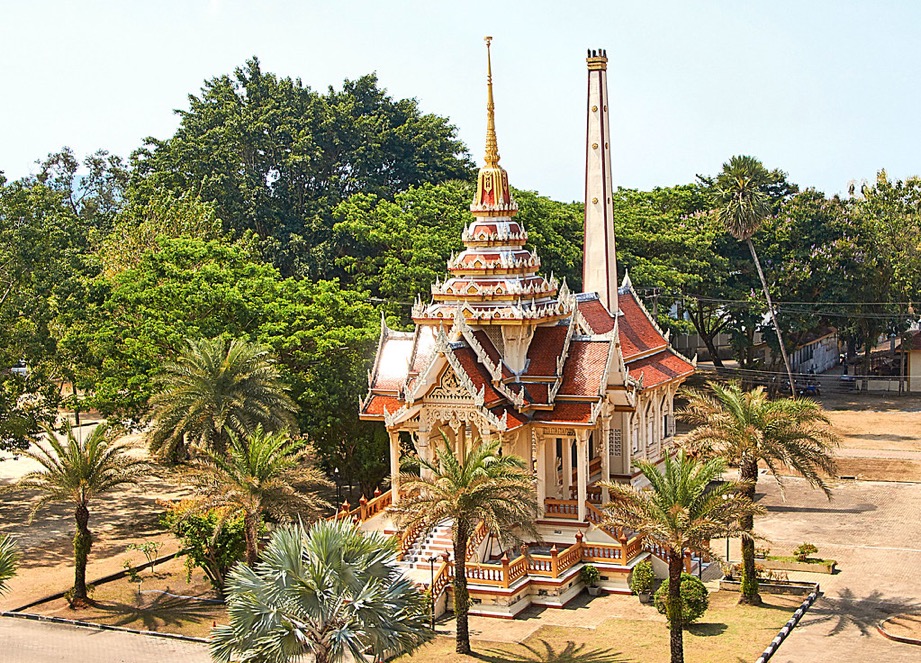
I'm going to visit the different buildings starting with the one that was nearest to our parking spot. It's the crematorium. Not all temples have the space for a crematorium, but it highlights that Wat Chalong is a fully working Buddhist temple serving a local community.
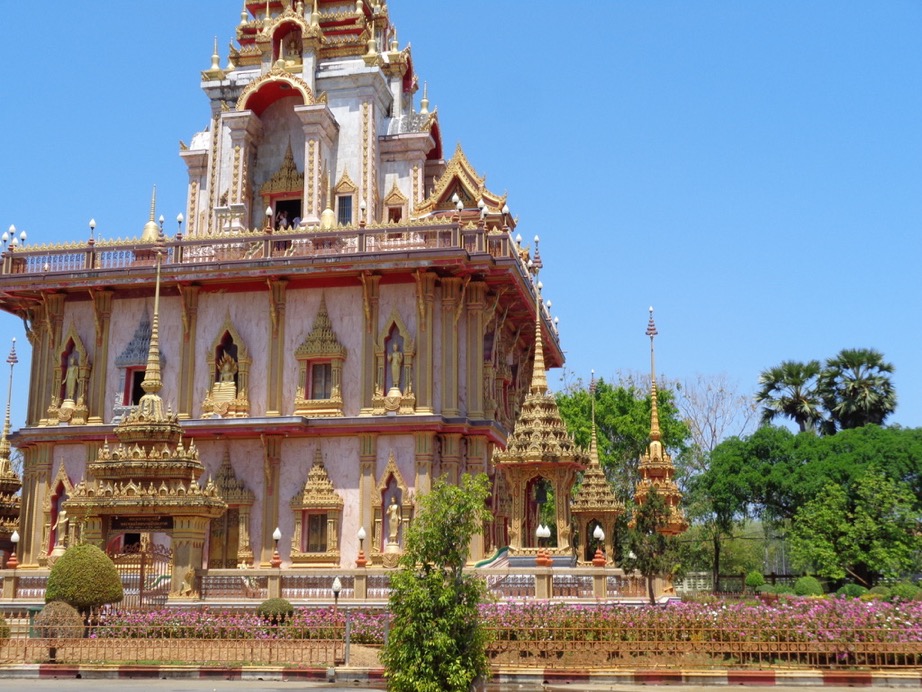
Near to the crematorium is the 61 metre tall 'chedi' (sometimes called Phra Mahathat Chedi). It's the tallest building on the site, and also the most recent. The foundations were laid in 1993 and the building cost 16 million Baht. It contains paintings of Buddha’s life and his teachings, and at the top there is a display which contains a sacred relic, a fragment of the Buddha’s bone, which was brought to the temple from Sri Lanka in 1999. We initially saw the building from the side, and it just looked too big for a 'chedi'. The building is often also called a pagoda, or even a combination of shrine and bell tower. Above we can see that the 'chedi' is quite an impressive building, but the crowning glory is the spire on the top that sits like a candle on an elaborately decorated cake.
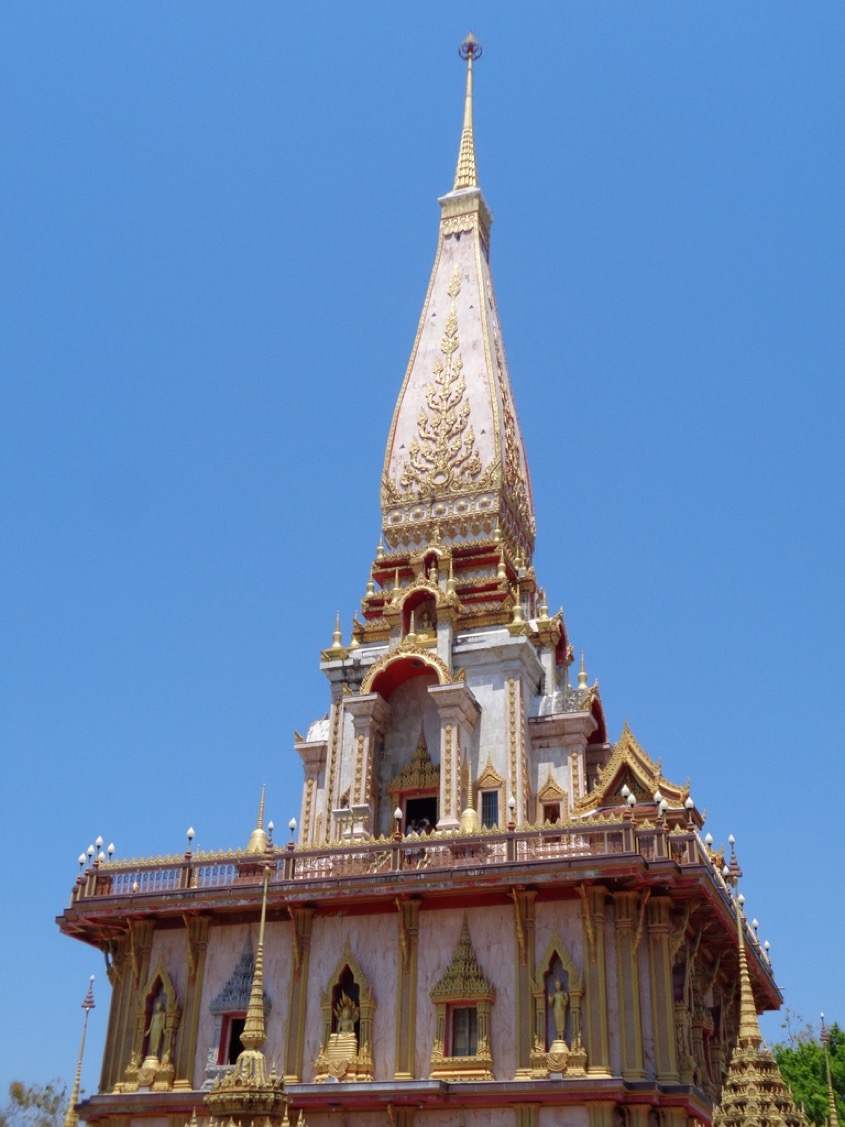
We walked around to the main entrance, took our shoes off and walked inside.

It's built on three floors, and there is a terrace area that provides an excellent view of the entire site, and beyond. On the ground floor there is a very elaborately decorated central room with a profusion of statutes of Buddha, and scenes of his life painted around the walls.
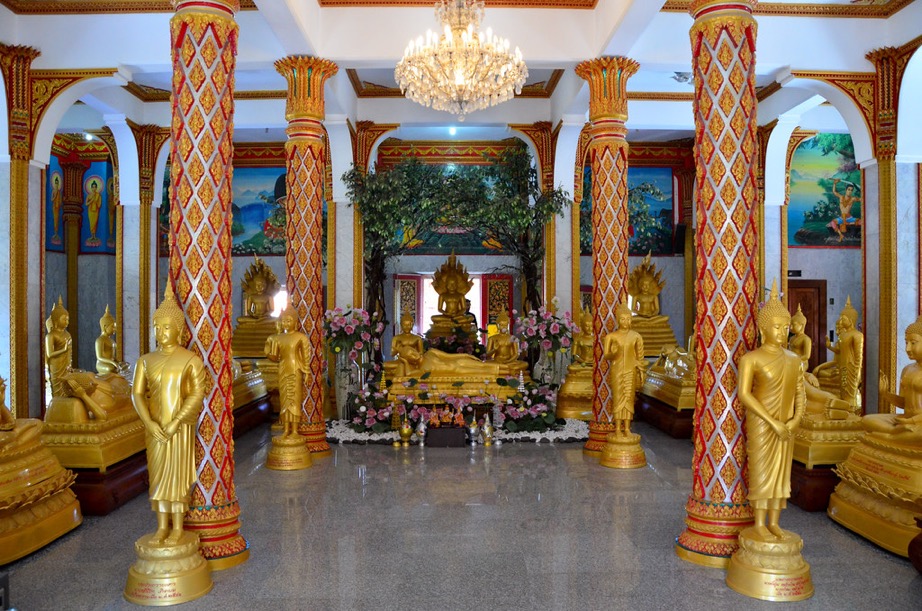
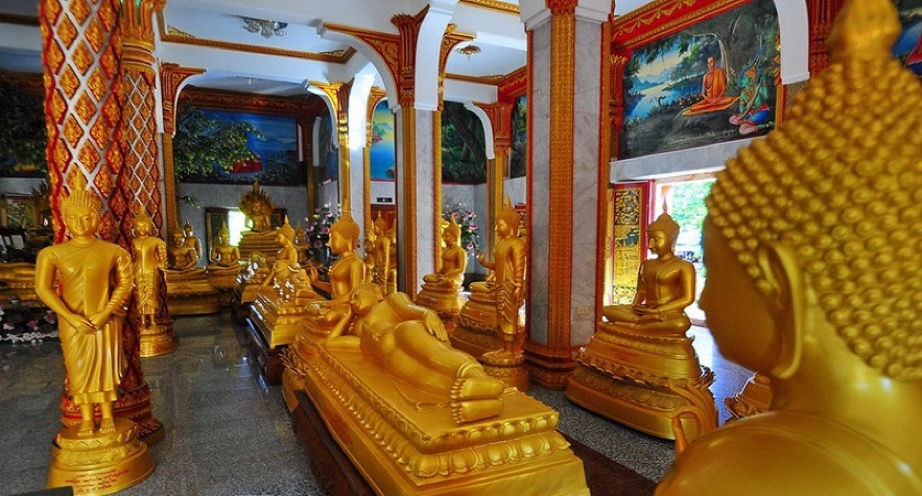
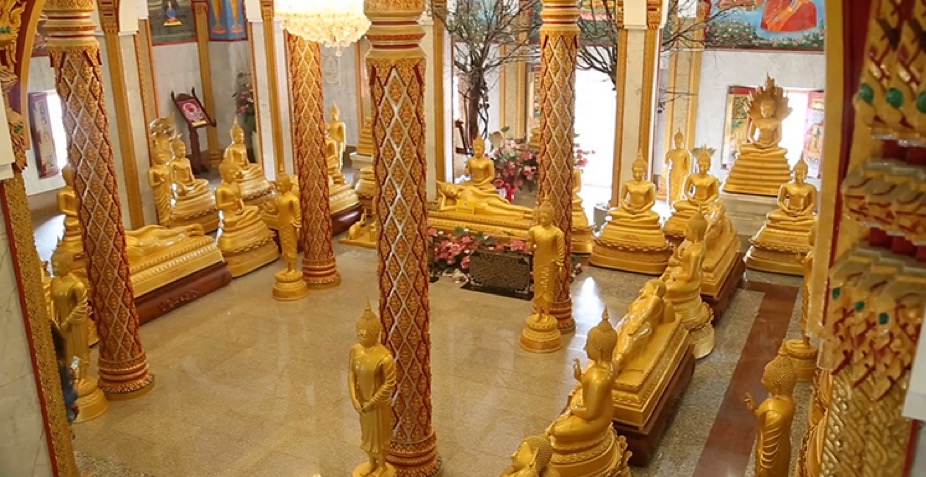
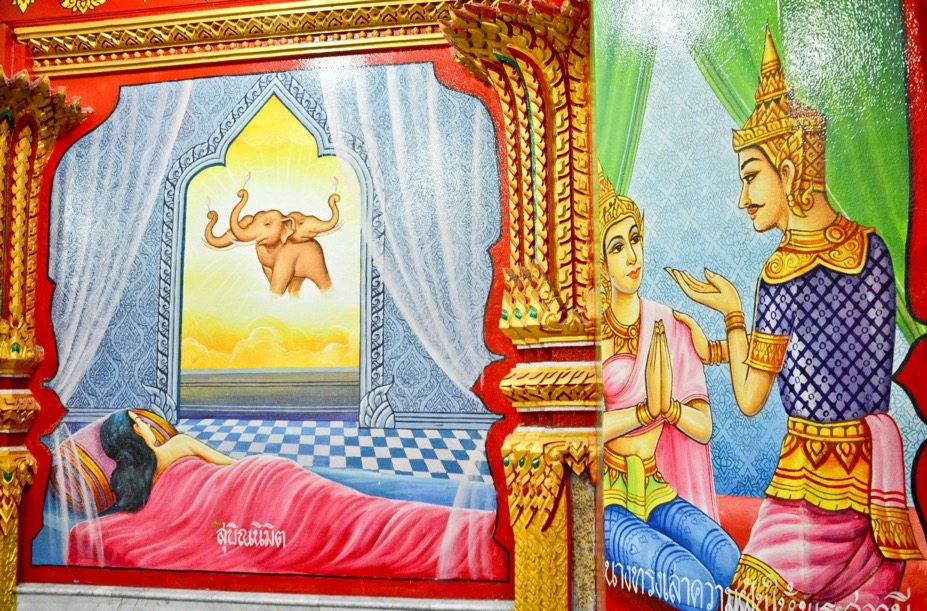
In the two far corners there were steps leading to an upper floor, decorated differently, but equally elaborately. I'm certain that the difference in the decoration between the ground and first floors has a significance, but I did not discover it.
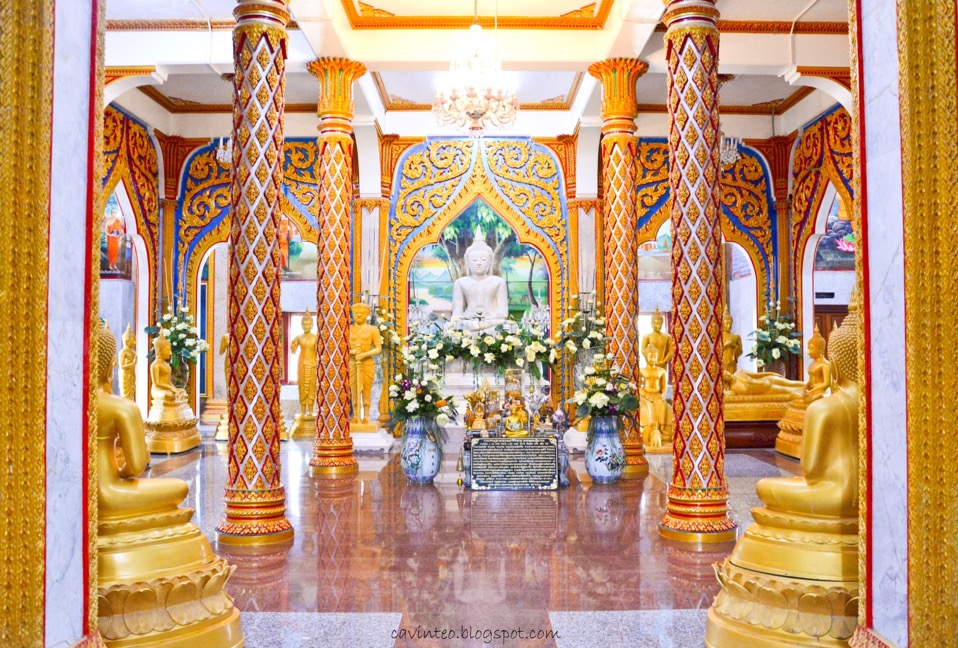
From this floor there were stairs leading up and out on to a terrace. From that terrace there were four sets of stairs that took us in to another upper floor.

And here, in a small room, was the relic of Buddha.
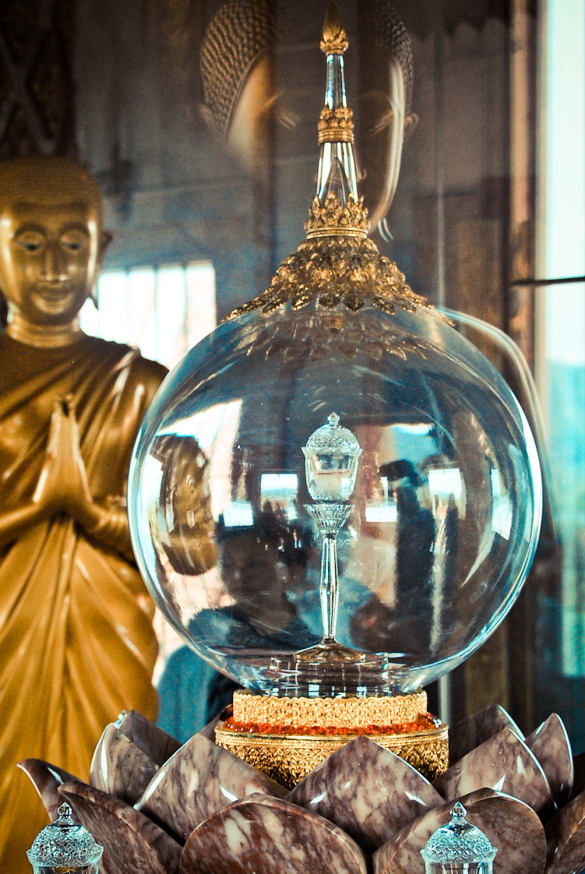
From the terrace we had a birds eye view of the temple site.
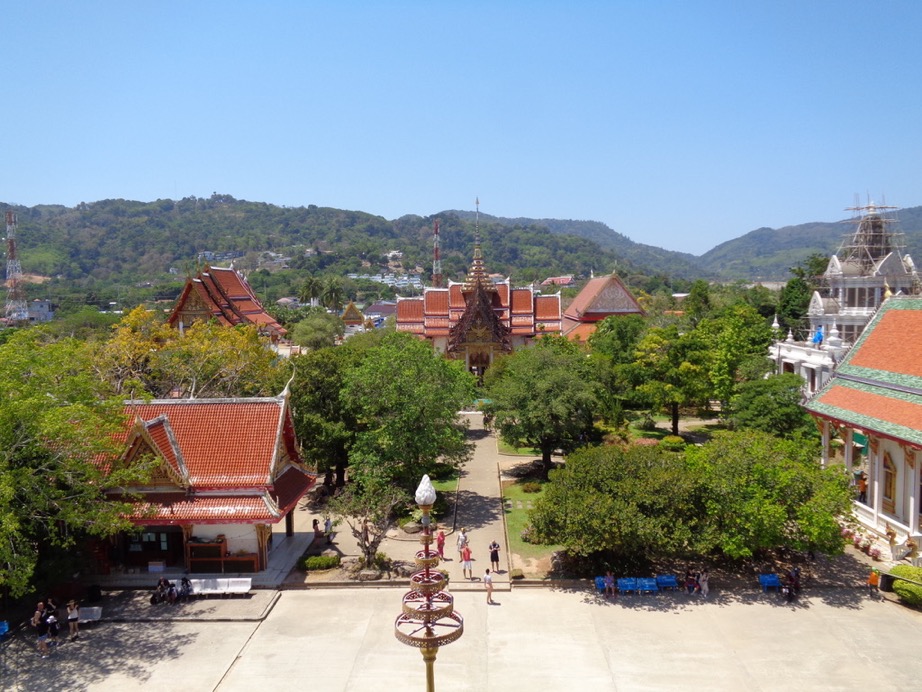
There is considerable confusion on the web about which building is the 'ubosot', which is the 'mondop', and which is the 'viharn'. As I noted earlier this is in part due to the fact that they look similar, except that a 'ubosot' is surrounded by eight boundary stones. There are numerous webpages that point to the central building in the above photograph as the 'ubosot', and a few suggest that it is the 'viharn'. I think it is the 'mondop'.
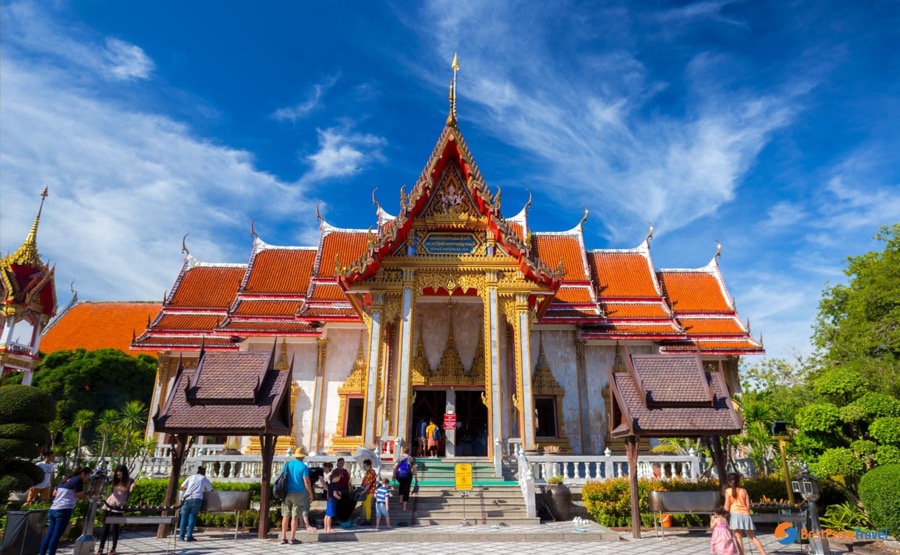
The 'mondop' is a relatively open building designed to house religious objects or books.
It is in this building that you can find the statues of Luang Poh Chaem, Luang Poh Chuang, and Luang Poh Gleum, all ex-abbots of the temple. These statues are made of bronze and Buddhists will make offerings to them in thanks for good health, or as a wish that a treatment will be successful. The offerings including lighting candles, offering lotus flowers, and covering the statues in gold leaf. It is also said that local people will also go to the temple to ask for the winning lottery numbers and pray for good luck and wealth.
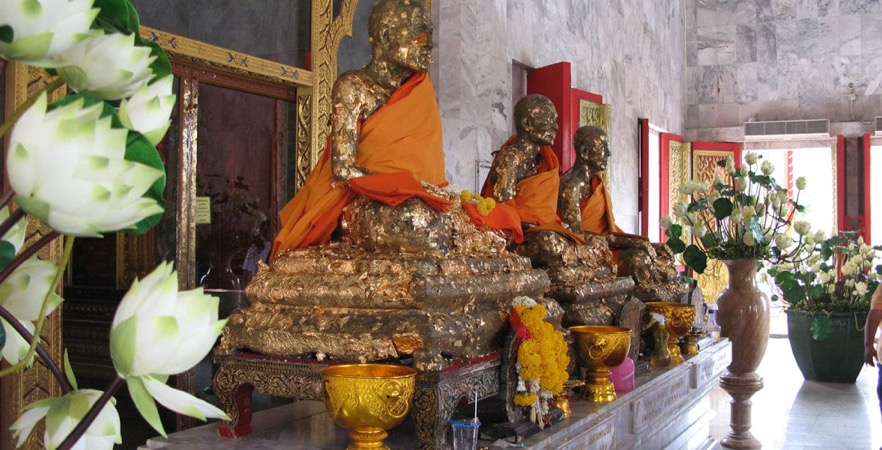
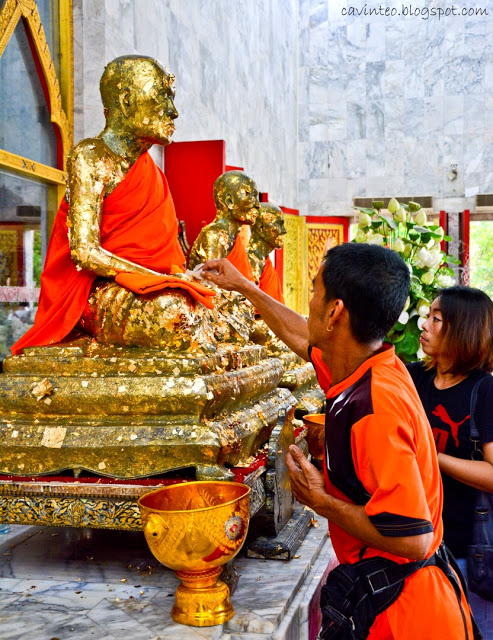

As I walked up the stairs to the 'mondop' I remember being intrigued by the complexity of the roof construction and decoration.

According to Wikipedia multiple roof tiers are ornamental and are reserved for temples, palaces and important buildings (you can find two, three and four tiered roofs). They are often found on large buildings such as temple halls, and the use of tiers helps lighten the roofs appearance. In the North of Thailand the roofs create larger overhangs than in the buildings we see here.
It is true that a 'mondop' is often seen as a baldachin-style, open-sided building with a multi-tiered pyramidal roof with a peak or spire. But I think this building has enough of the key feature, and we must remember that we cannot see the eight boundary stones of a 'ubosot'.
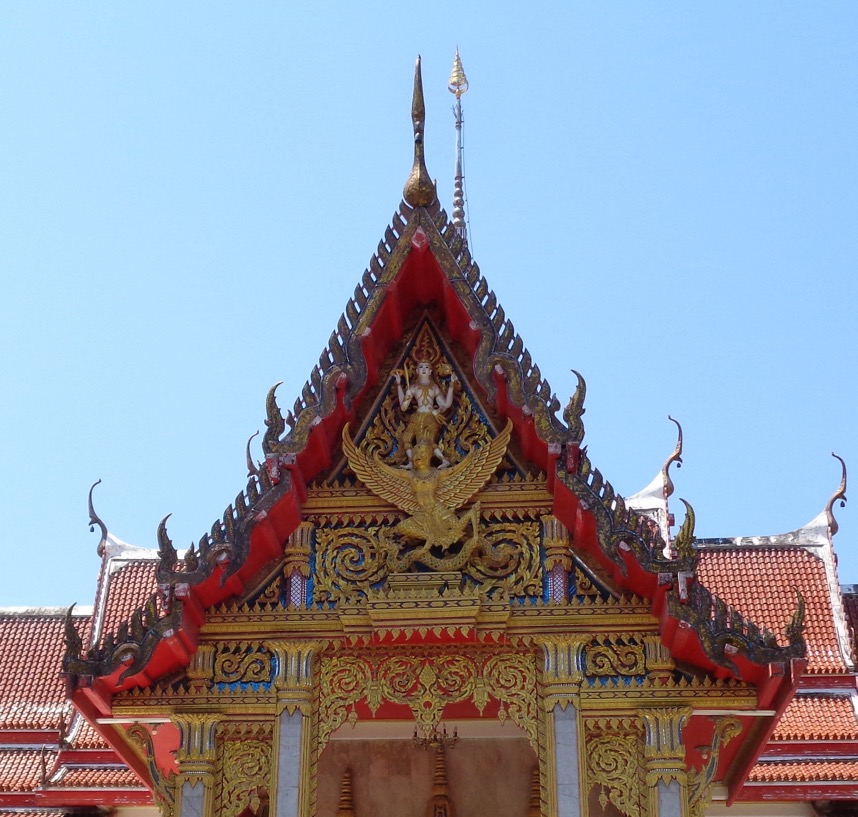
Here we can see the highly decorated gable above the entrance nearest to the 'chedi'. The design and complexity of temple gables depends upon the wealth of the temple and the skill of the craftsmen. The pelmets or cornice boards ('kong khieu') that hang under the arches created by columns and gables are said to represent the eyebrows of the Buddha.
I remember reading somewhere that we are looking at Vishnu dominating a Garuda (a kite-like figure) who is sitting above a 'nāga' (a serpent-like figure). Many mythical creatures are presented in pairs, constantly at war with each other. The giant birdlike Garuda is often seen attacking snakelike nāgas. It is said the feud happened when their respective mothers married the same husband. He gave each one a single wish. Nāgas mother wished for a thousand children. Garuda's mother wished for just two children who were both superior to all of the nāgas. Later Garuda's mother lost a bet and became the servant and prisoner of the nāgas' mother. So the Garuda swore vengeance, and have been fighting nāgas ever since.
The origin of these stories dates back, perhaps 3,000 years, but the characters have evolved differently in the different cultures and religions. In Hinduism, Garuda is a single character that carries the God Vishnu on his back. In Buddhism, Garuda is an agent of the faith, wrestling with nāgas until a person becomes a Buddhist. And of course Garuda is the national symbol of Thailand and Indonesia. Despite nāgas being perpetually punished, they are not evil, and are worshiped in their own right. It must be said that the story of birds attacking snakes appears in almost every culture, so it's certainly not surprising to see it also in Thailand.
I've already mentioned that the Garuda are horn or bird-like finials on the roof ridges of temples, and some may even have bells that tinkle in the winds. So even in the context of a simple roof, what we see is the Garuda grabbing nāga's tail as it flows down both sides of the bargeboard.
PS - if you are really interested in the stories of the Garuda and nāgas then have a look here, although I think it probably only scratches the surface.
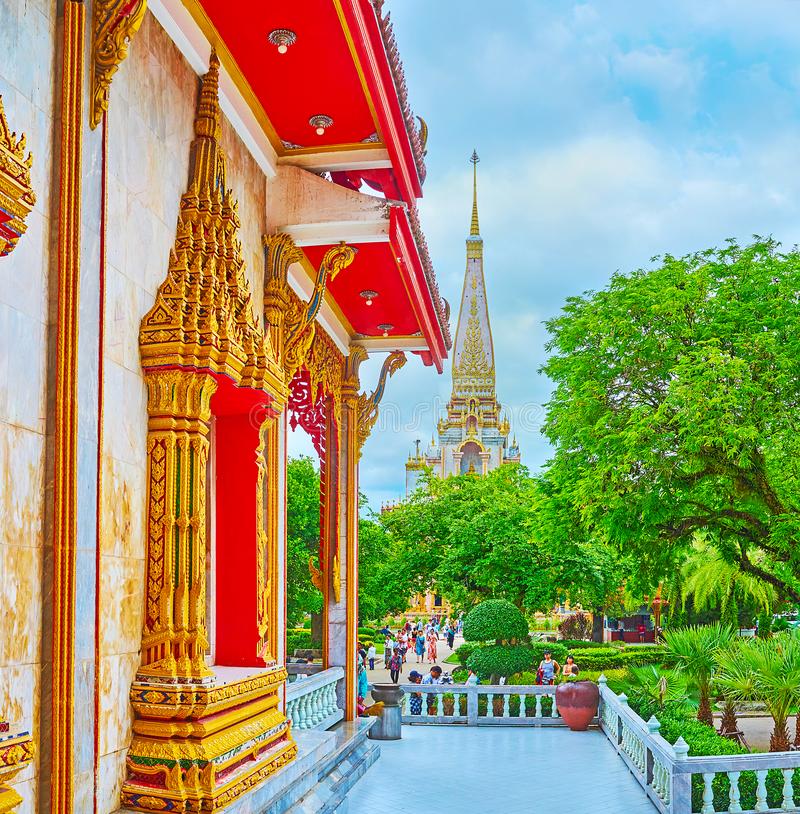
These buildings are such a rich source of both inspiration and historical context. Triangle eave-brackets can be highly ornamental, and are often called elephant ears ('hu chang'). Designs can include intertwining 'nāga's, the monkey king Hanuman, or the mystical bird 'Kinnara'.
Leaving the 'mondop' by what was in fact the main entrance, we see right in front of us, also alined East-West, the temples 'ubosot'.

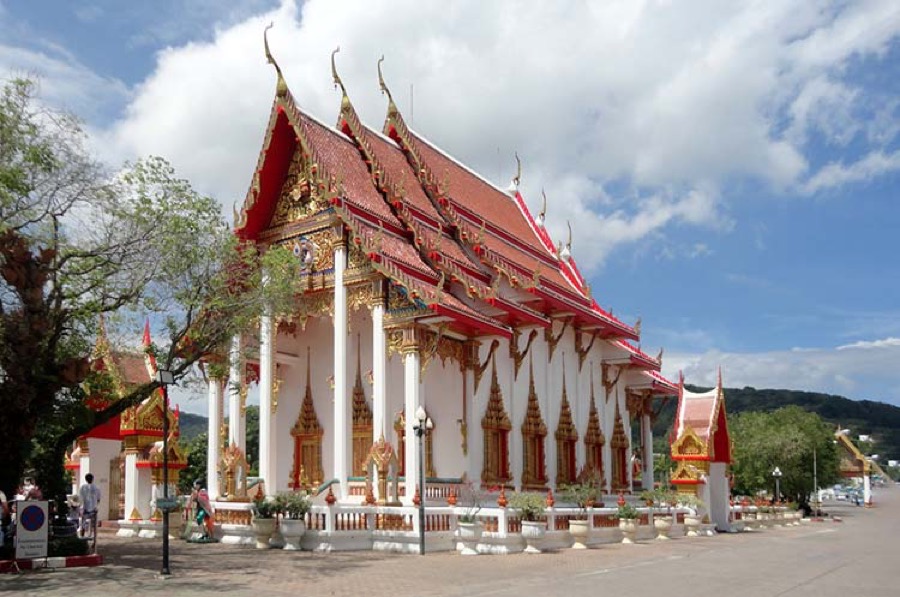
The 'ubosot' is surrounded by eight boundary stones, and is not open to the public. It is the monks’ sanctuary, where they are ordained and where items such as Luang Poh Chaem’s walking stick are kept safe. It is believed that the walking stick had (or has) healing powers. A number of people claim to have been cured of stomach pains after being touched with the stick.

And just to prove that these boundary stones exist, and that this building is in fact the 'ubosot',you can see above three of the eight boundary stones placed in their own protective enclosures.
I was not able to identify the 'Ho Trai' (a manuscript store or library, usually small but lavishly decorated, and bit like a ubosot or viharn). An I think that the 'Sala gan parian', an open-sided pavilion or preaching hall, was over the back of there site, but we did not visit it.

However, one interesting thing near both of the above mentioned temple buildings was a kiln. This is used to light the fireworks that are constantly being set-off. The idea is that grateful supplicants buy strings of fireworks and have them detonated to signify that a prayer has been answered. Thais, like Chinese, love their firecrackers. It looks as if any excuse is good for a few fireworks. Others tell you that the loud sound is to scare away evil spirits, and yet others will tell you that setting off fireworks signifies prosperity – the more you light, the more your life will improve. The real reason is that people just get a thrill out of setting them off, and any excuse will do “Nowadays, people will light firecrackers for almost any occasion – an auspicious ceremony, the Vegetarian Festival, funerals, moving into a new home... pretty much any big event. At Wat Chalong, many people make a vow to have a good working life. When their vow is fulfilled, they may light 2,000-3,000 firecrackers, but the number is really up to them”.
Background reading
There is a massive number of websites, webpages, etc. dedicated to visiting Thailand and Phuket. I have no intention of listing them here, just Google what you are looking for…
The Siam Society provides free access to back issues of their publications, The Journal of The Siam Society and The Natural History Bulletin. They also have an interesting list of special publications such as Before Siam: Essays in Art and Archaeology.